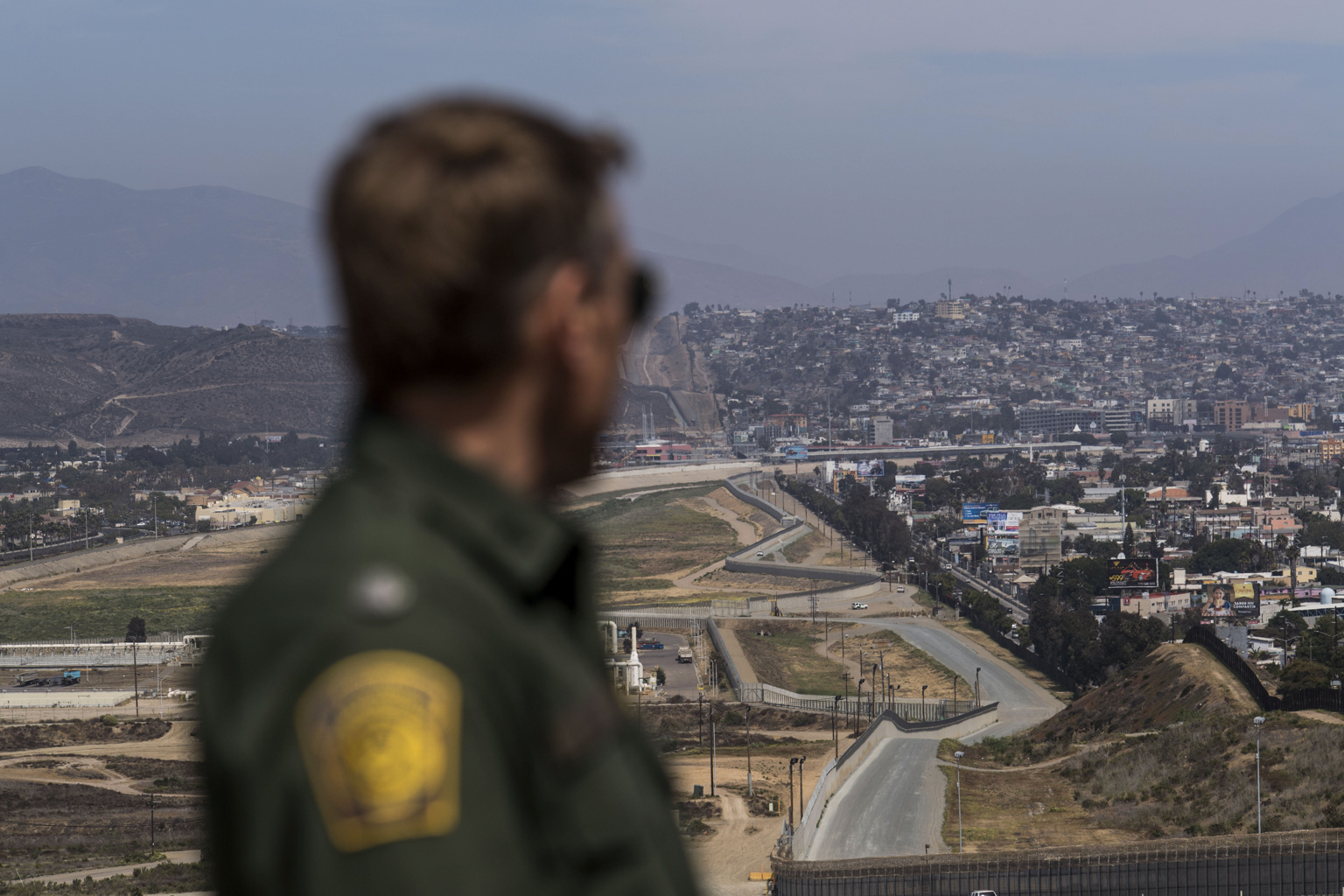
The Road to Asylum: Inside the Migrant Caravans
Throughout 2018 thousands of Central American migrants made the journey from their home countries, often traveling more than 2500 miles across Mexico in caravans to reach the U.S. border. Unsure of what to do next as asylum processes constantly seem to change in the news, they have to decide whether to wait, to turn back, or to cross illegally, often with children in tow. However, if they are lucky, once they cross, the most uncertain, and longest part of their journey – the asylum process – has just begun.
Rodney Scott, chief of the Border Patrol's San Diego sector, looks out towards Tijuana, Mexico, right, as Border Patrol agents respond to a call about people crossing in the distance on April 25, 2018 in San Diego, California.
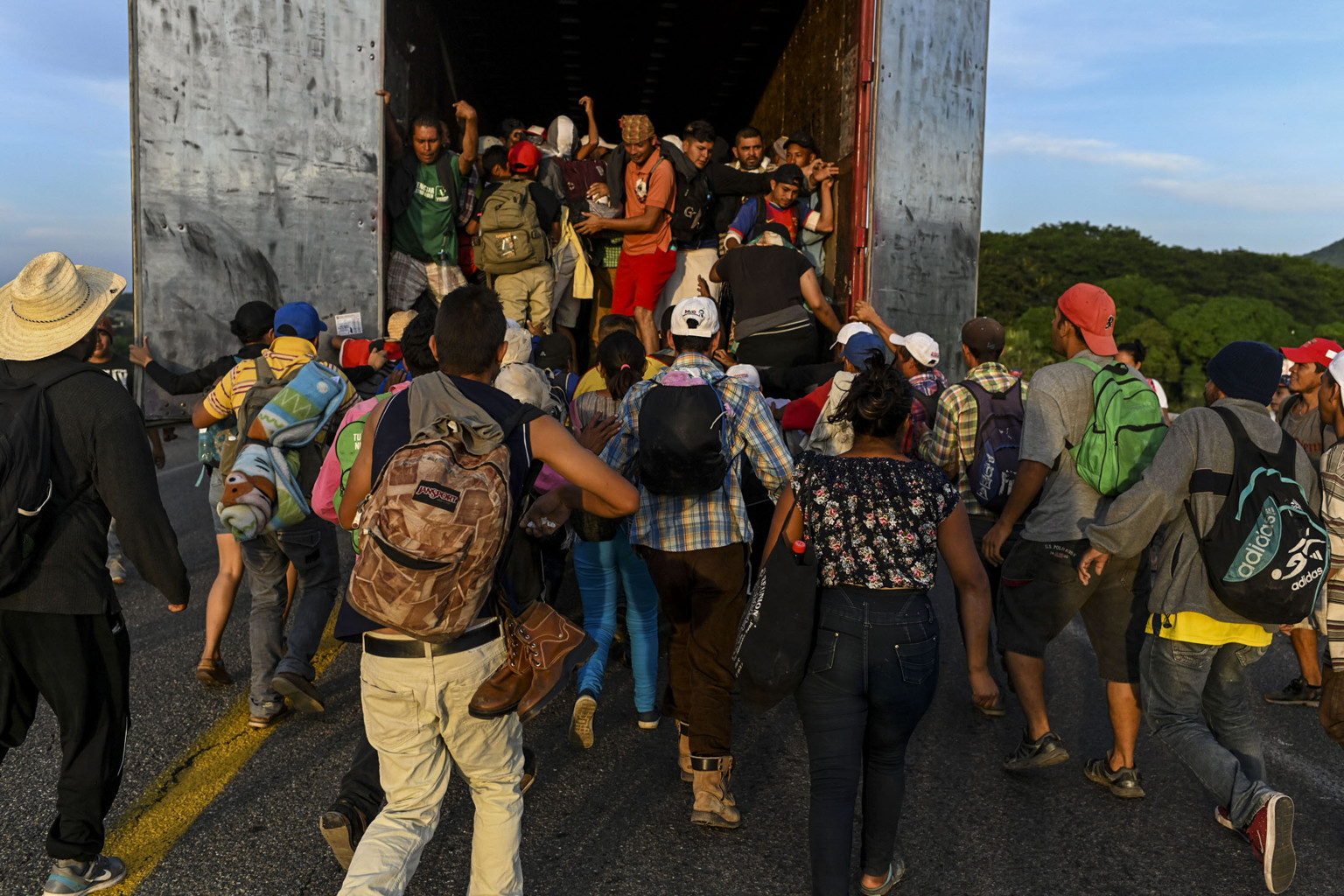
The Road to Asylum: Inside the Migrant Caravans
SANTIAGO NILTEPEC, MEXICO - OCTOBER 30: Dozens of migrants traveling in a caravan towards the United States border run behind a truck and help each other climb inside on a highway in Santiago Niltepec, Mexico on their way to Juchitan, Mexico on October 30, 2018. The truck did not stop moving when the migrants started climbing in. The migrant caravan was traveling about 30 miles a day, so people were desperate to catch rides however they could in order to avoid walking such long distances every day. (Photo by Carolyn Van Houten/The Washington Post)
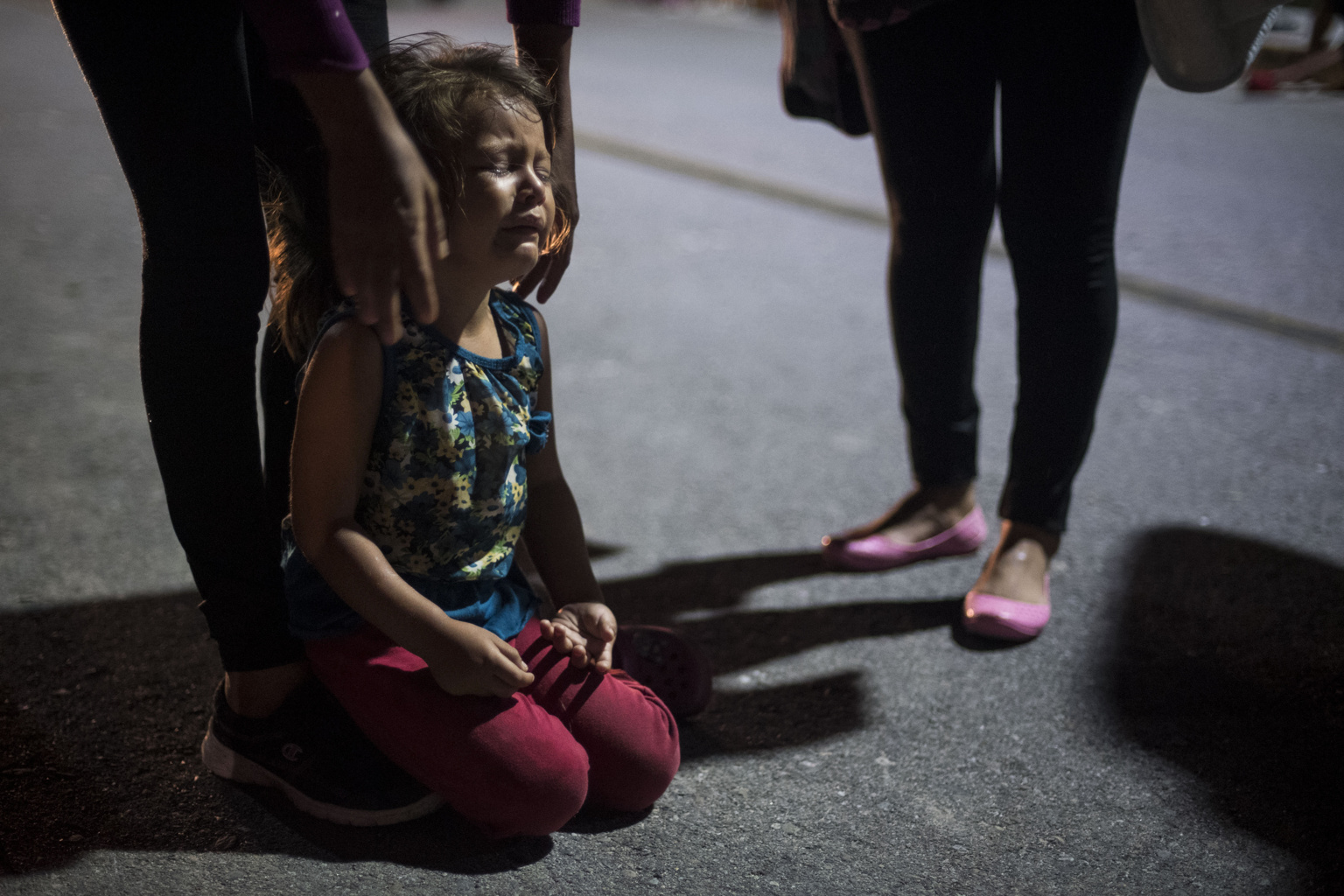
The Road to Asylum: Inside the Migrant Caravans
LA VENTOSA, MEXICO - OCTOBER 29: Bessi Zelaya, Johana Hernandez, 16, and Ana Lizeth Velasquez, stand in the road and try to help Keila Savioll Mejia, 21, as her daughter Camila Savioll Mejia, 4, throws a tantrum and refuses to walk any farther in San Pedro Tapanatepec, Mexico on October 29, 2018. They are walking north together among the thousands of migrants traveling in a caravan to the United States border. (Photo by Carolyn Van Houten/The Washington Post)

The Road to Asylum: Inside the Migrant Caravans
JUCHITAN, MEXICO - OCTOBER 30: Thousands of migrants traveling in a caravan towards the United States border rest after traveling more than 30 miles to Juchitan, Mexico on October 30, 2018. Some hitched rides for parts of the journey while others walked. This night they stayed in a stadium complex, which was turned into a temporary camp. Thousands slept here in rows, often only inches apart from each other. Medical care and food were provided. (Photo by Carolyn Van Houten/The Washington Post)

migrantcaravan
JUCHITAN, MEXICO - OCTOBER 30:Brandon Garcia, right, 21, watches his son Caleb Isaac Flores, 7, center, who broke both of his arms recently while playing with other migrant children, in Juchitan, Mexico on October 30, 2018. Thousands of people are a part of the caravan which is heading north to the United States border. (Photo by Carolyn Van Houten/The Washington Post)
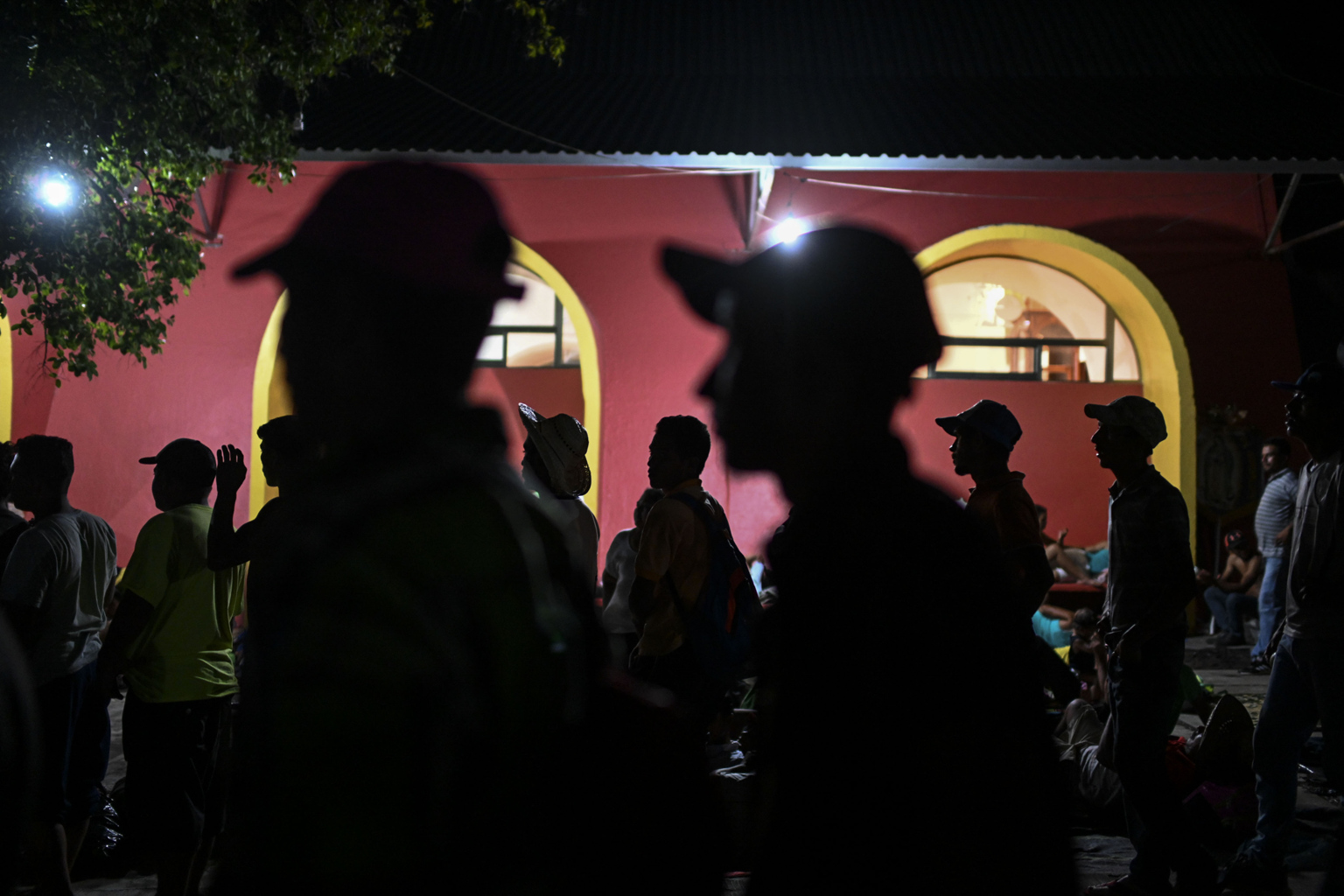
The Road to Asylum: Inside the Migrant Caravans
SAN PEDRO TAPANATEPEC, - OCTOBER 28: Some of the thousands of migrants traveling in a caravan towards the United States border stand in line for food in San Pedro Tapanatepec, Mexico on October 28, 2018. Often the men stand in line for food after the families and children have been fed. (Photo by Carolyn Van Houten/The Washington Post)
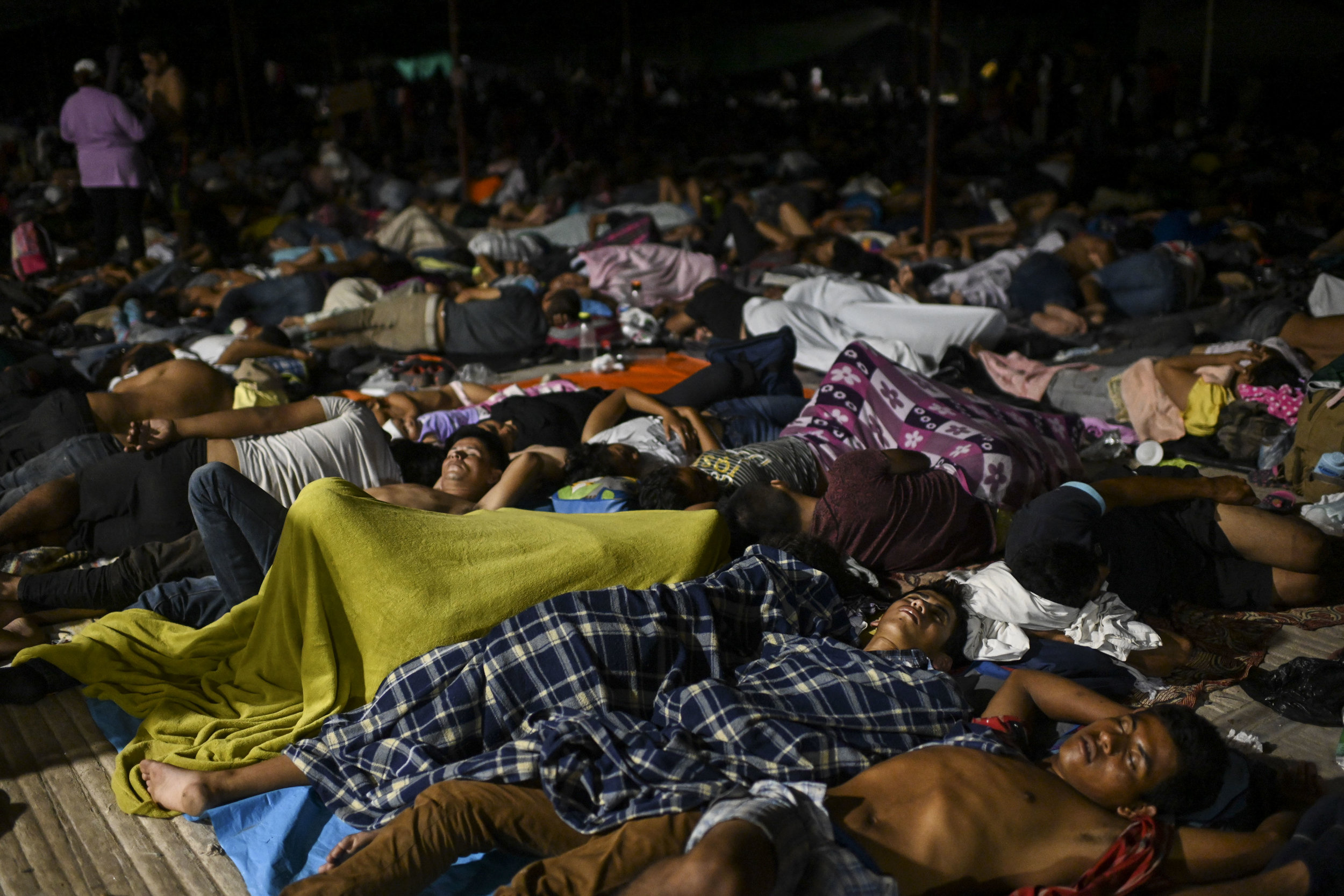
The Road to Asylum: Inside the Migrant Caravans
Thousands of migrants rest before they continue their walk north towards the United States border in Juchitan, Mexico on November 1, 2018. To get to the border, they are hitching rides on trucks, taking buses, and often walking long distances.

The Road to Asylum: Inside the Migrant Caravans
Almairis Guillen and her son Miguel de Jesus Oseguera, 4, ride on the wheel well of a tanker truck along a highway in Santiago Niltepec, Mexico on their way to Juchitan, Mexico on October 30, 2018. Traveling as a part of the caravan of thousands of migrants, the Honduran mother of five is hoping to make it to the U.S. to ask for asylum. “The truth is that I don’t know if they will help us,” she said.
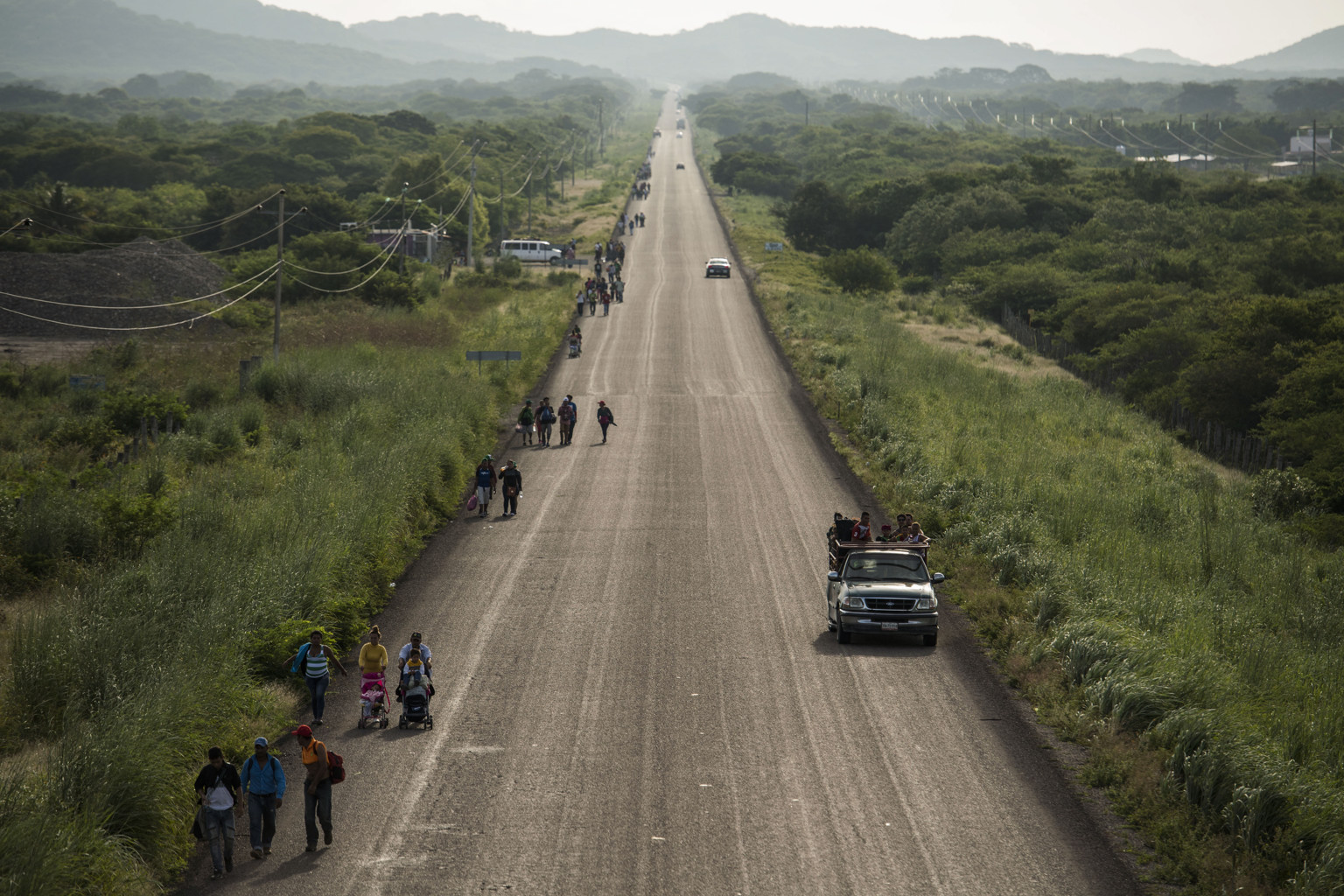
The Road to Asylum: Inside the Migrant Caravans
SANTIAGO NILTEPEC, MEXICO - OCTOBER 30: Some of the thousands of migrants traveling in a caravan towards the United States border walk along the side of a highway while others hitch a ride in a truck in Santiago Niltepec, Mexico on their way to Juchitan, Mexico on October 30, 2018. While hundreds caught rides from local passersby or leapt onto passing trucks, those methods were risky for many families with small children, so they often walked straggling behind the rest of the group. (Photo by Carolyn Van Houten/The Washington Post)
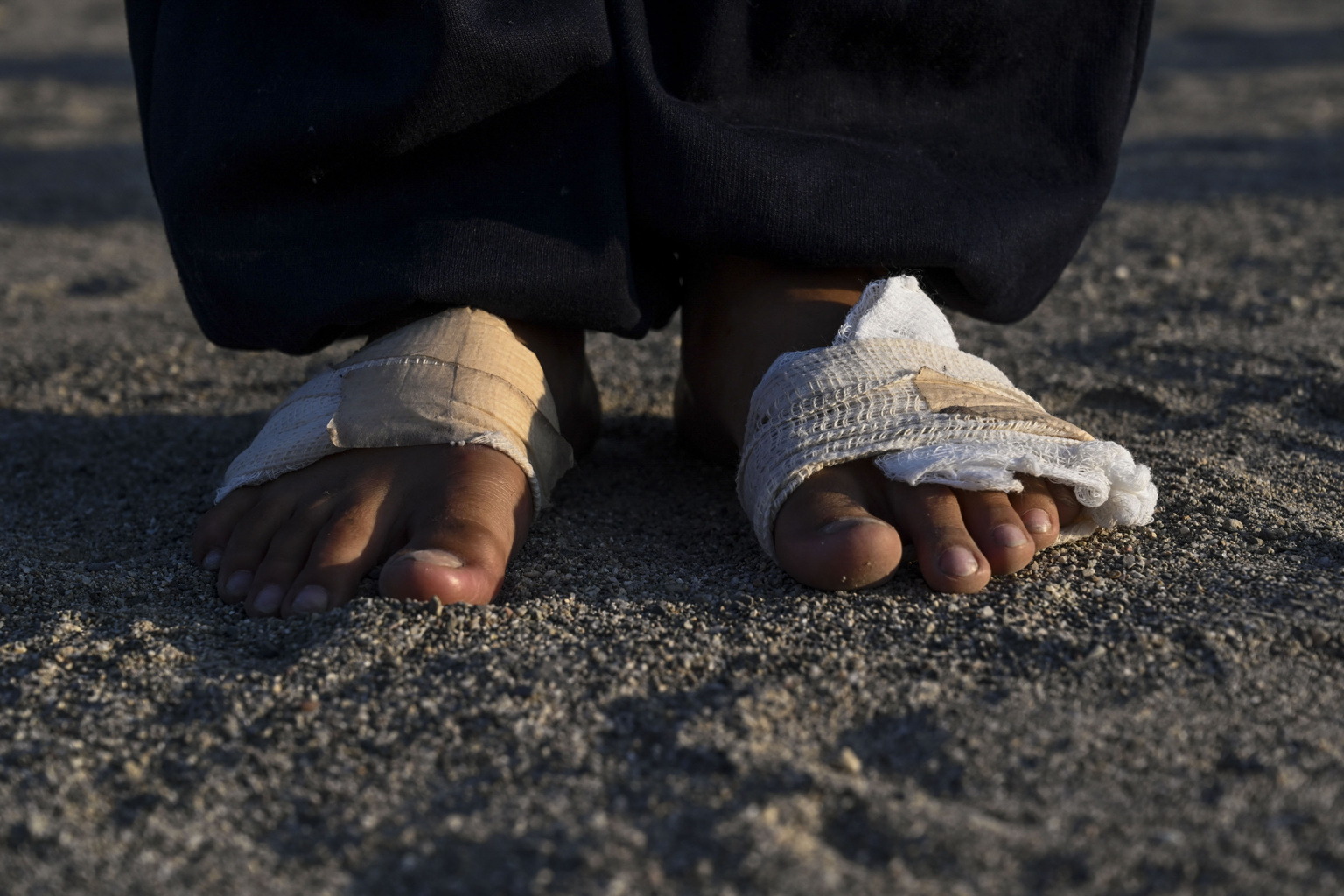
The Road to Asylum: Inside the Migrant Caravans
JUCHITAN, MEXICO - OCTOBER 31: Keneth Arguijo Gonzalez, 10, stands with his feet wrapped to cover the open blisters and heat damage that are affecting his feet as the migrant caravan he is traveling with rests in Juchitan, Mexico on October 31, 2018. Thousands of people are a part of the caravan which is heading north to the United States border. To get to the border, they are hitching rides on trucks, taking buses, and often walking long distances. (Photo by Carolyn Van Houten/The Washington Post)
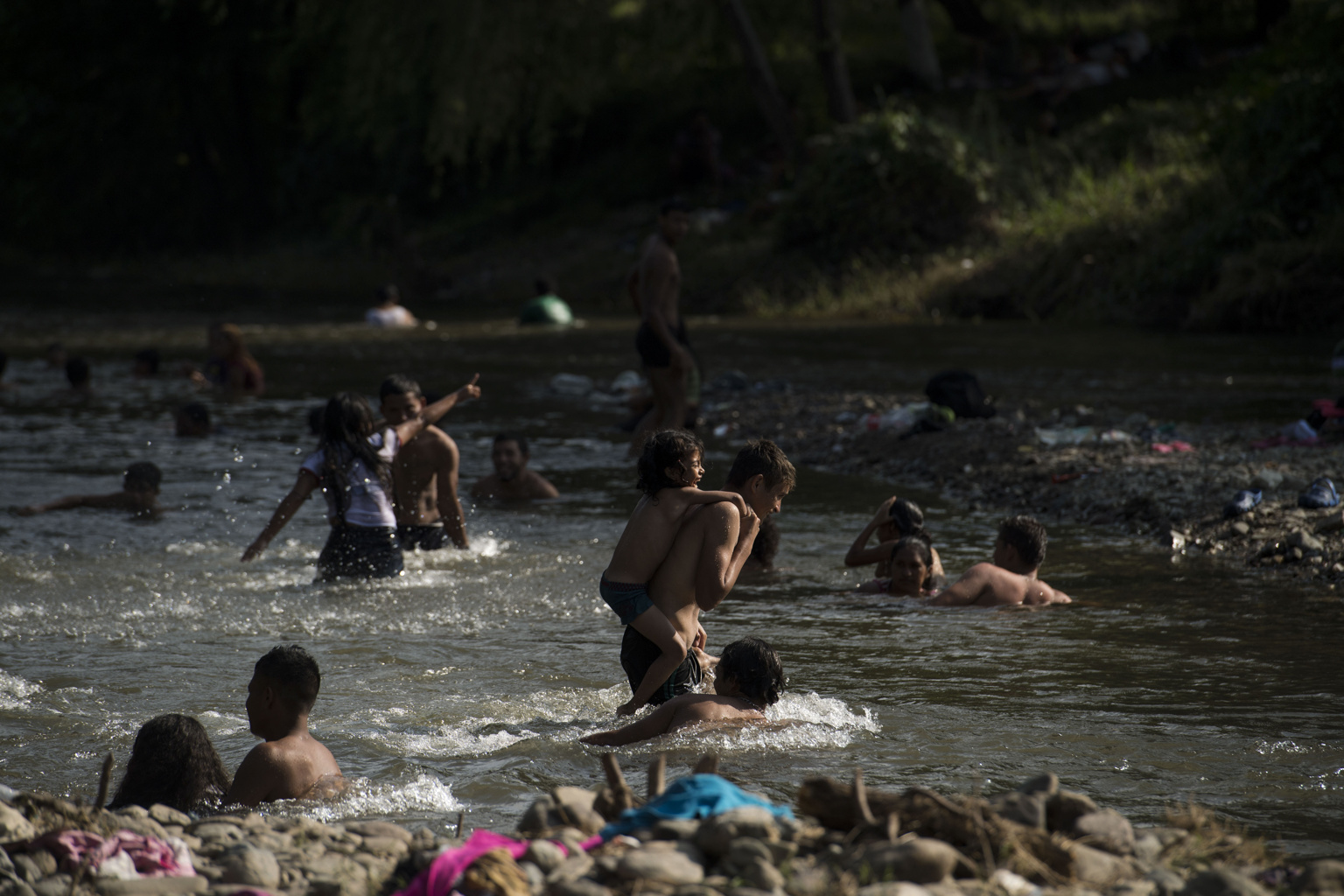
The Road to Asylum: Inside the Migrant Caravans
SAN PEDRO TAPANATEPEC, - OCTOBER 28: Some of the thousands of migrants traveling in a caravan towards the United States border play and wash off in the Rio Novillero in San Pedro Tapanatepec, Mexico on October 28, 2018. Occasionally, the caravan would remain in a town for an extra day along their route to rest, wash, and take care of any medical issues people may have incurred along the journey. The scene was lighthearted and playful, despite exhaustion and heat. (Photo by Carolyn Van Houten/The Washington Post)
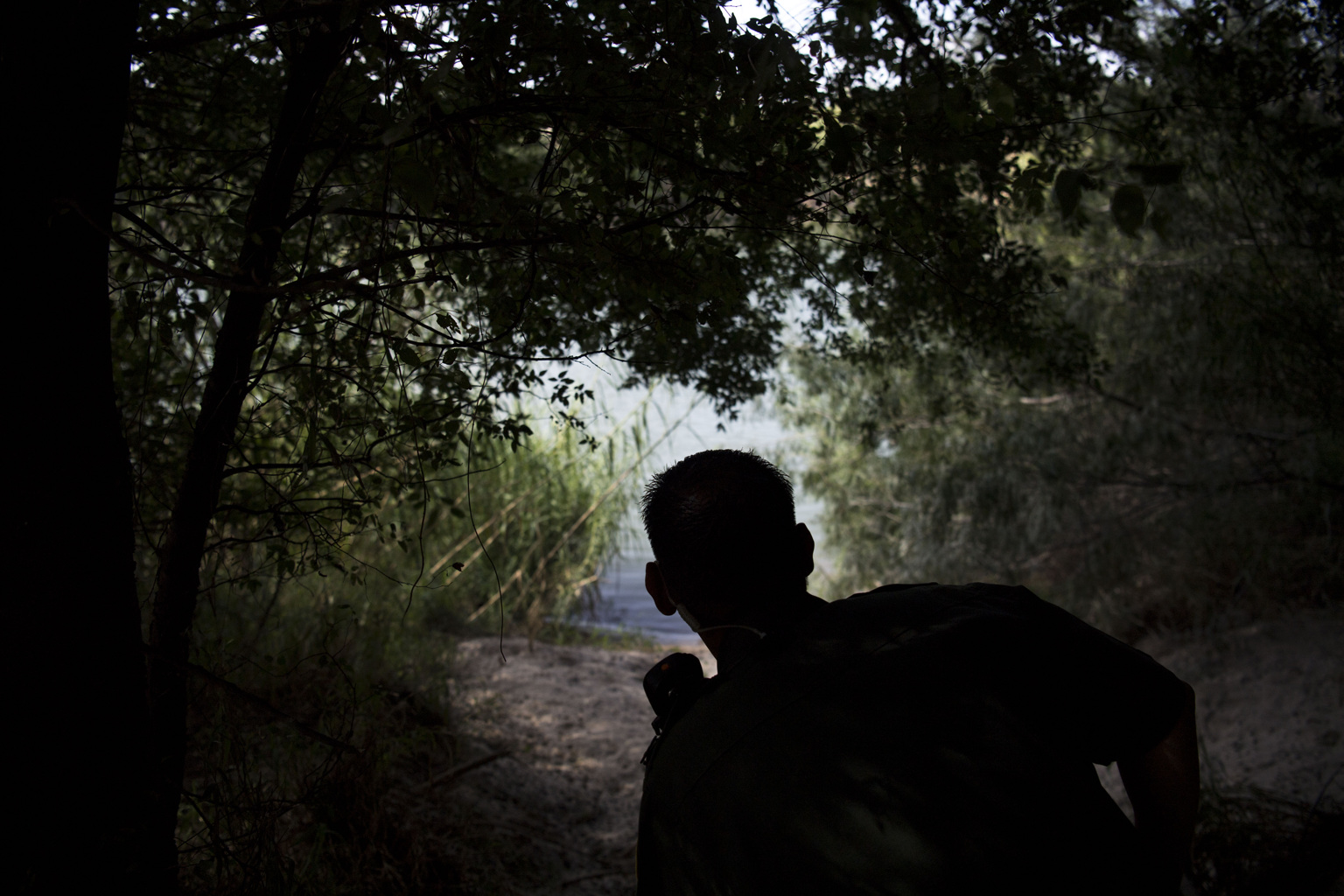
The Road to Asylum: Inside the Migrant Caravans
HIDALGO COUNTY, TEXAS - AUGUST 15: Border Patrol agent Robert Rodriguez watches a group of smugglers in Mexico from the United States side of the Rio Grande River in Hidalgo County, Texas on August 15, 2018. A young smuggler paddled a raft across the river carrying Cecilia Ulloa, 25, and her son, Darwin, 13. The Hondurans were crossing in hopes of seeking asylum in the United States. (Photo by Carolyn Van Houten/The Washington Post)
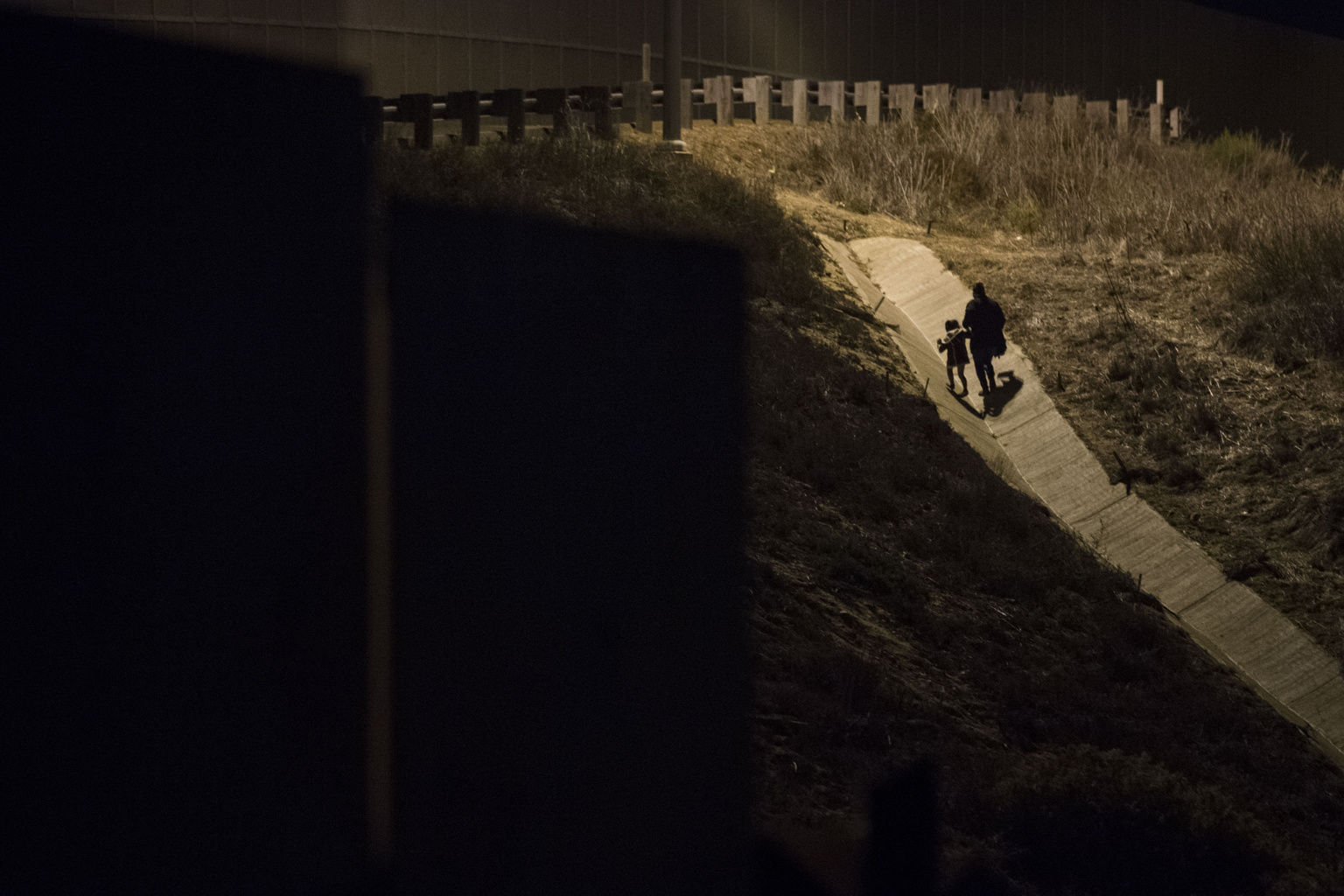
The Road to Asylum: Inside the Migrant Caravans
TIJUANA, MEXICO - DECEMBER 2: A group of migrants, including a child, cross the border fence illegally to present themselves to Border Patrol agents on December 2, 2018 in Tijuana, Mexico. Many migrants who are a part of the migrant caravan have chosen to cross illegally and ask for asylum rather than wait weeks, or possibly even months, in a shelter until their turn comes to legally present themselves to ask for asylum at a border checkpoint. (Photo by Carolyn Van Houten/The Washington Post)

bordercrossing
EL PASO, TEXAS - FEBRUARY 22:Migrant families walk around the area with mylar blankets in order to stay warm while waiting for about an hour to be processed and transported by Border Patrol in El Paso, Texas on February 22, 2019. The mylar blankets were distributed by Border Patrol agents to protect against the near-freezing temperatures while the migrants wait to be processed and transported to a nearby holding facility. The group of 64 migrants walked across the Rio Grande river and presented themselves to Border Patrol agents near the BNSF Rail Yard on the western edge of downtown El Paso. Many of the Central American migrants are families asking for asylum in the United States. (Photo by Carolyn Van Houten/The Washington Post)
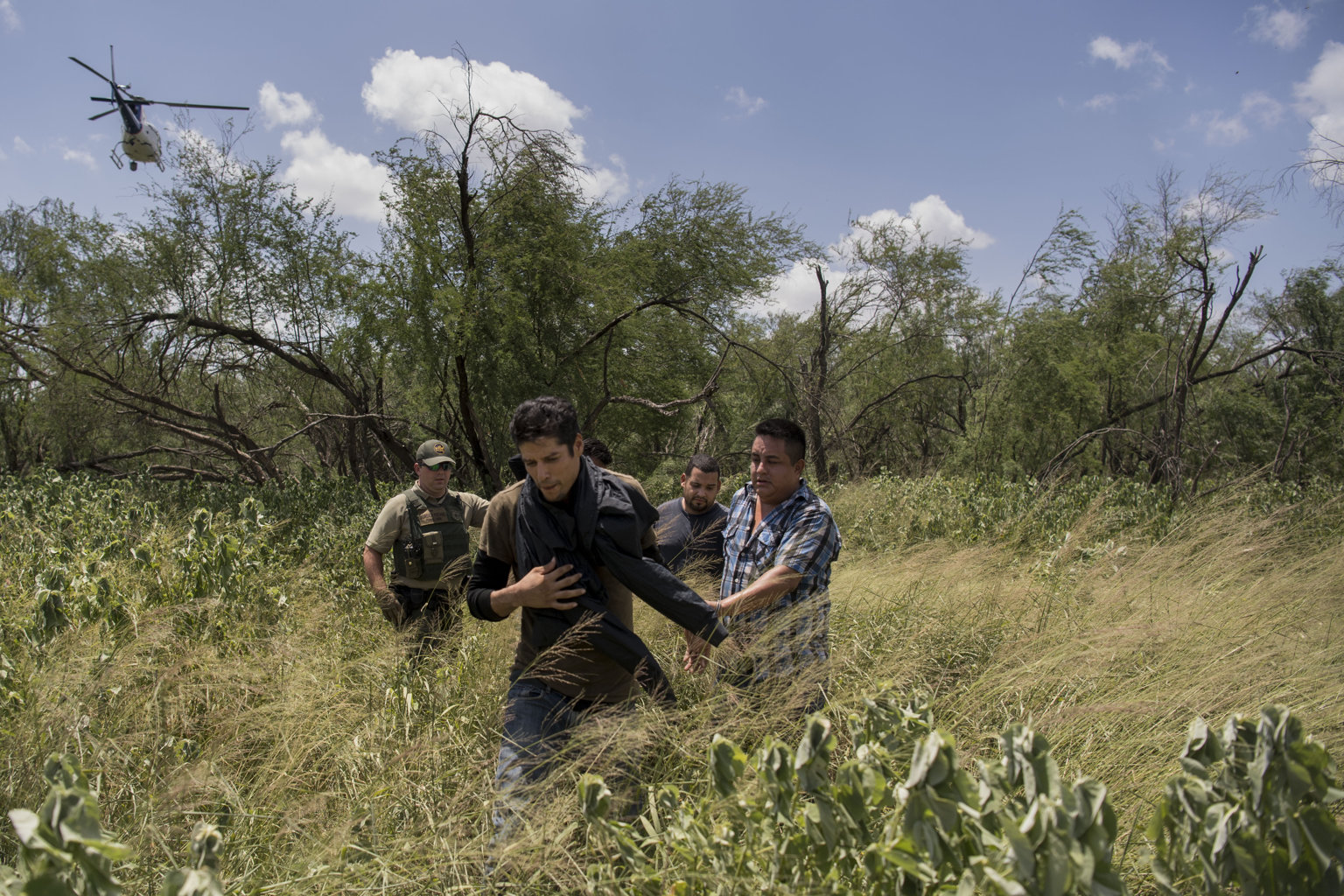
The Road to Asylum: Inside the Migrant Caravans
MISSION, TEXAS - AUGUST 15: A group of men who crossed the U.S. border illegally and tried to run from Border Patrol agents are detained in Mission, Texas on August 15, 2018. The Border Patrol used helicopters, cameras, and agents on foot to track the men as they tried to flee. The men were quickly detained, given an electrolyte beverage, processed and placed in a van for transport. Much of the national narrative around asylum is muddled with the conversation about illegal immigration. (Photo by Carolyn Van Houten/The Washington Post)
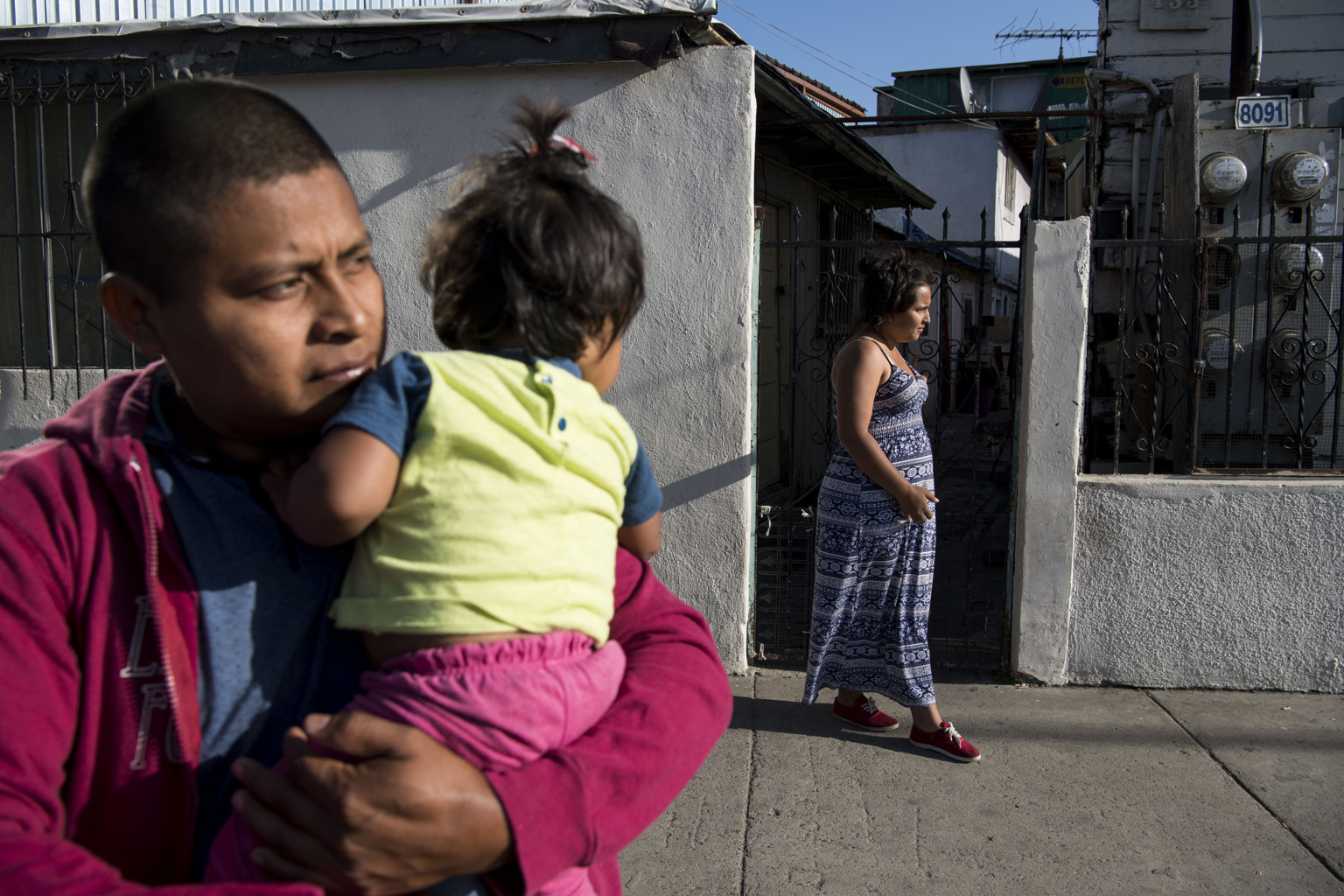
The Road to Asylum: Inside the Migrant Caravans
TIJUANA, MEXICO - APRIL 26: Elvia Ramos, right, looks down the street as her partner Carlos Aldana holds their daughter Fernanda Aldana-Ramos, 1, at the Movimiento Juventud 2000 shelter on April 26, 2018 in Tijuana, Mexico. Ramos and her family fled Honduras after two of Aldana's brothers were killed and their lives were threatened. Hundreds of migrants from Central America traveled for about a month across Mexico to reach the United States border. A few days later they went to the San Ysidro border crossing south of San Diego, California, where they and many of the migrants in the caravan sought asylum. (Photo by Carolyn Van Houten/The Washington Post)
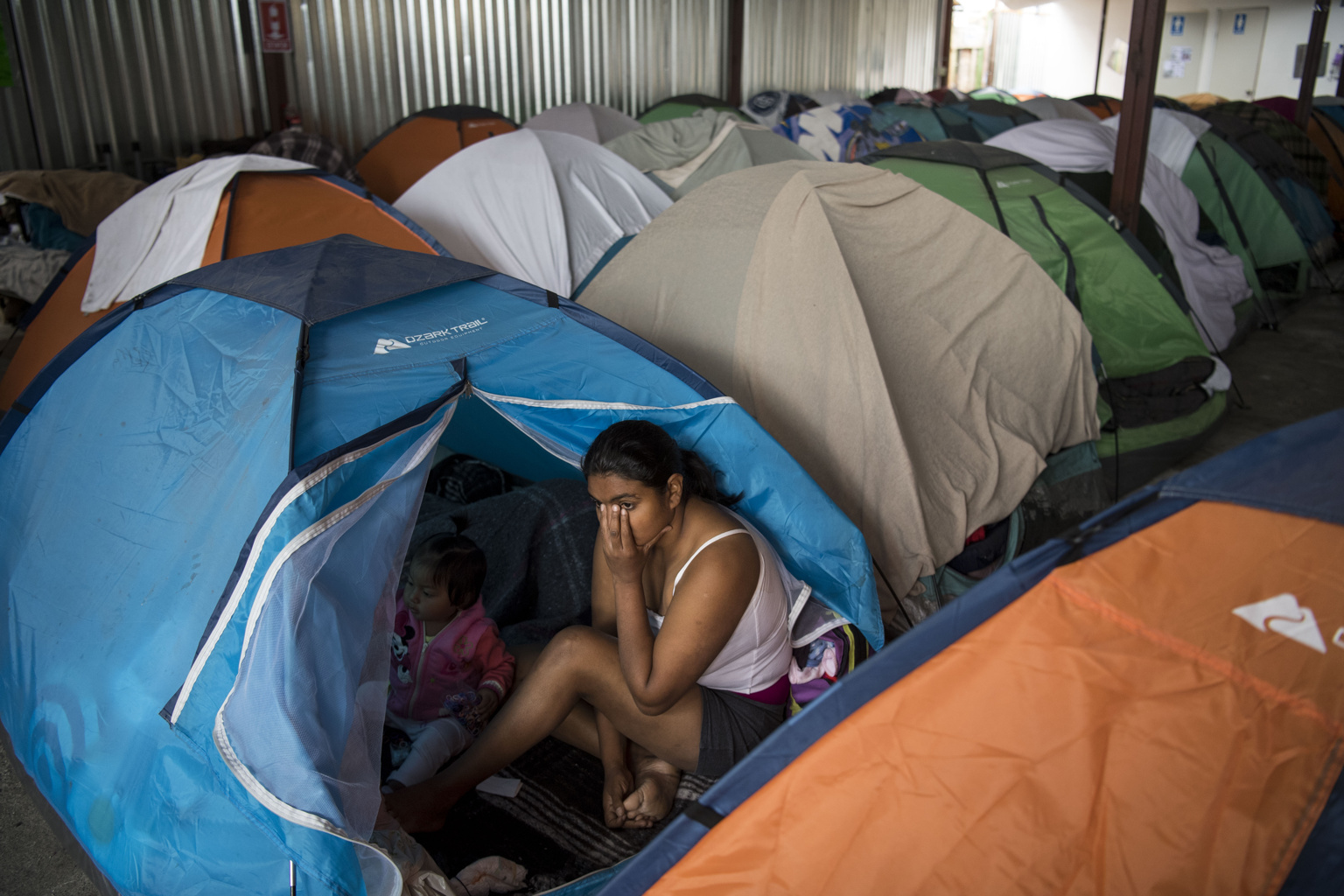
The Road to Asylum: Inside the Migrant Caravans
TIJUANA, MEXICO - MAY 14: Ingrid Hernandez sits in silence in her friend Elvia Aldana's tent in the Movimiento Juventud 2000 shelter in Tijuana, Mexico after trying and failing to reach her husband Misael Bonilla in the immigration detention center where he and their son, Leonel, were being held on May 14, 2018. She was trying to find out if they were going to be released soon, because she did not want to present herself and her other two children at the border until she knew Misael and Leonel were safe and with her father in the Bronx, New York. While sitting in the tent, she talked to Elvia about her concerns and their plan to walk to the San Ysidro border crossing to find out how long they needed to wait to present themselves and ask for asylum. Ingrid was conflicted because she did not want to cross without hearing from Misael, but she also did not want her family to miss their place in the waiting list to ask for asylum. If she decided to postpone, the three of them would have to stay in the shelter at least another week. (Photo by Carolyn Van Houten/The Washington Post)
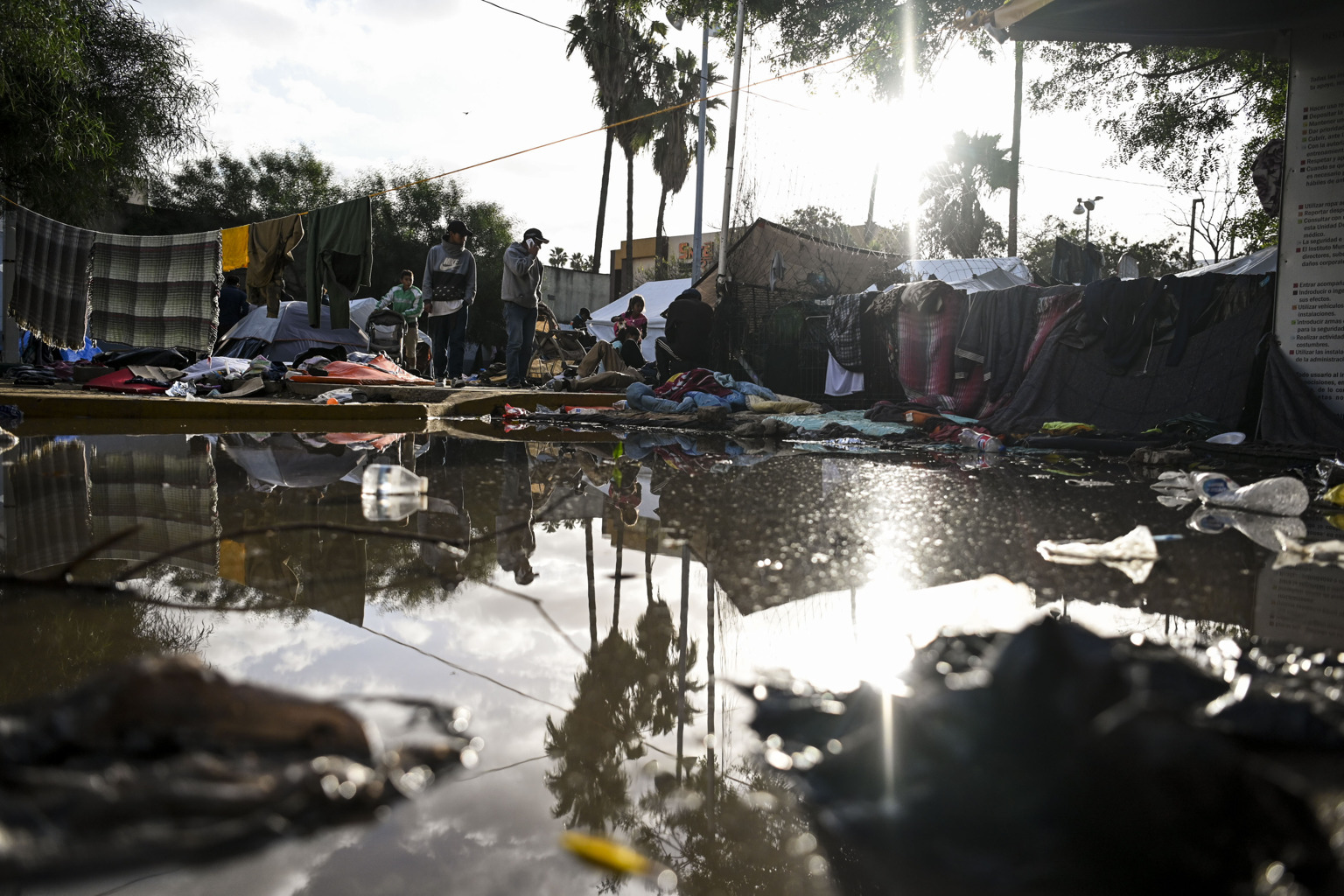
The Road to Asylum: Inside the Migrant Caravans
TIJUANA, MEXICO - NOVEMBER 30: Standing water remains after heavy rains flooded the stadium complex where members of the migrant caravan were staying in tents on November 30, 2018 in Tijuana, Mexico. Partially due to the squalid conditions, the thousands of migrants with the caravan were moved to a different shelter across the city. (Photo by Carolyn Van Houten/The Washington Post)
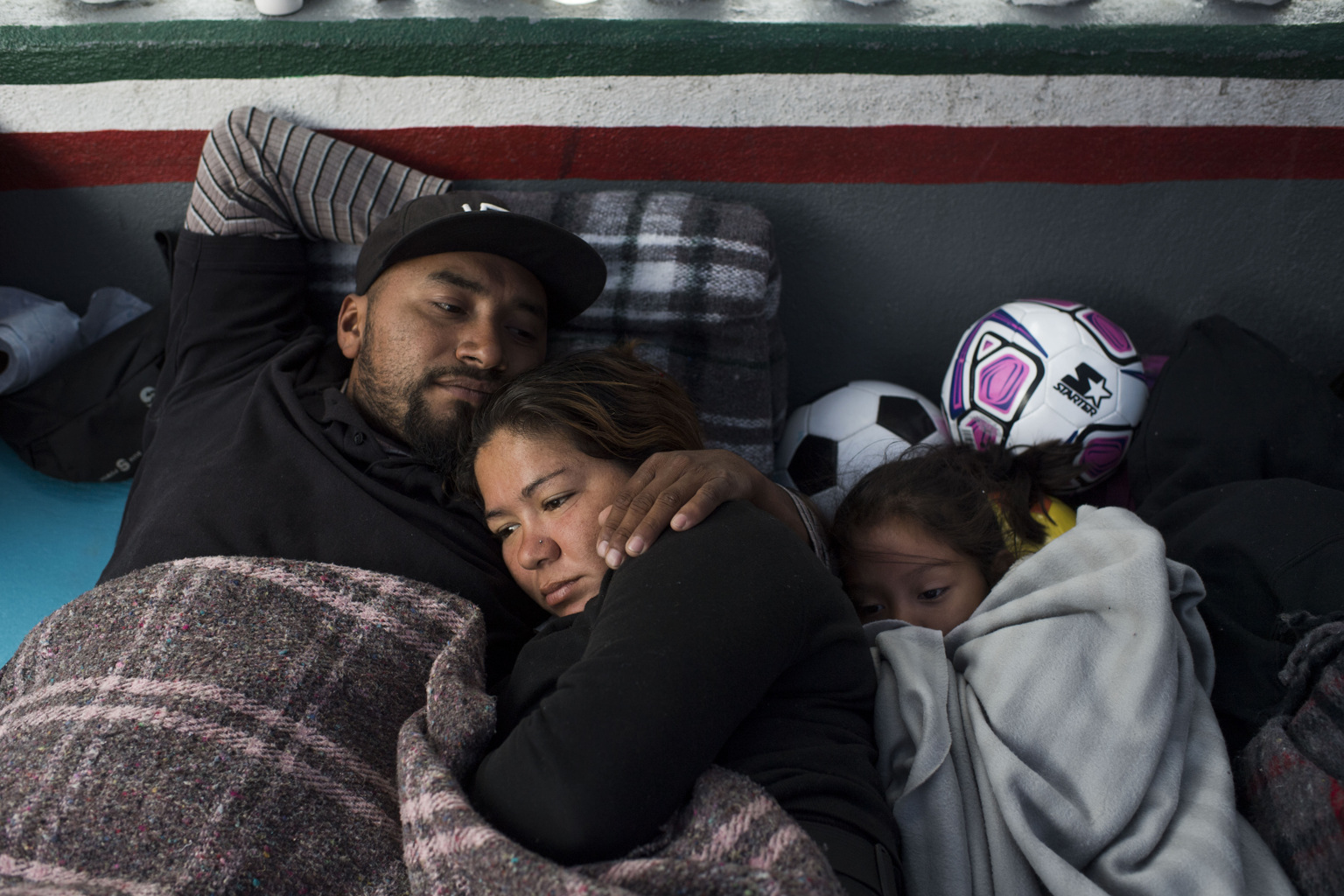
The Road to Asylum: Inside the Migrant Caravans
TIJUANA, MEXICO - MAY 1: Evelyn Vega lays her head on Elmer Zelaya Gomez while their daughter Nayely Vega, 7, rests next to them under a tarp that is attached to the bars on the edge of the San Ysidro border crossing on May 1, 2018 in Tijuana, Mexico. They are among the group of Central American migrants waiting to walk to the United States border and have their cases processed. Stripes representing the Mexican flag loom over their heads as if a reminder of how far they still have to go. "We want to start another life, but it is not easy," Gomez said. A gang in his home country of El Salvador killed his son in February and threatened his family, he said. Hundreds of migrants from Central America traveled for about a month across Mexico to reach the United States border. Many of the migrants will seek asylum. (Photo by Carolyn Van Houten/The Washington Post)
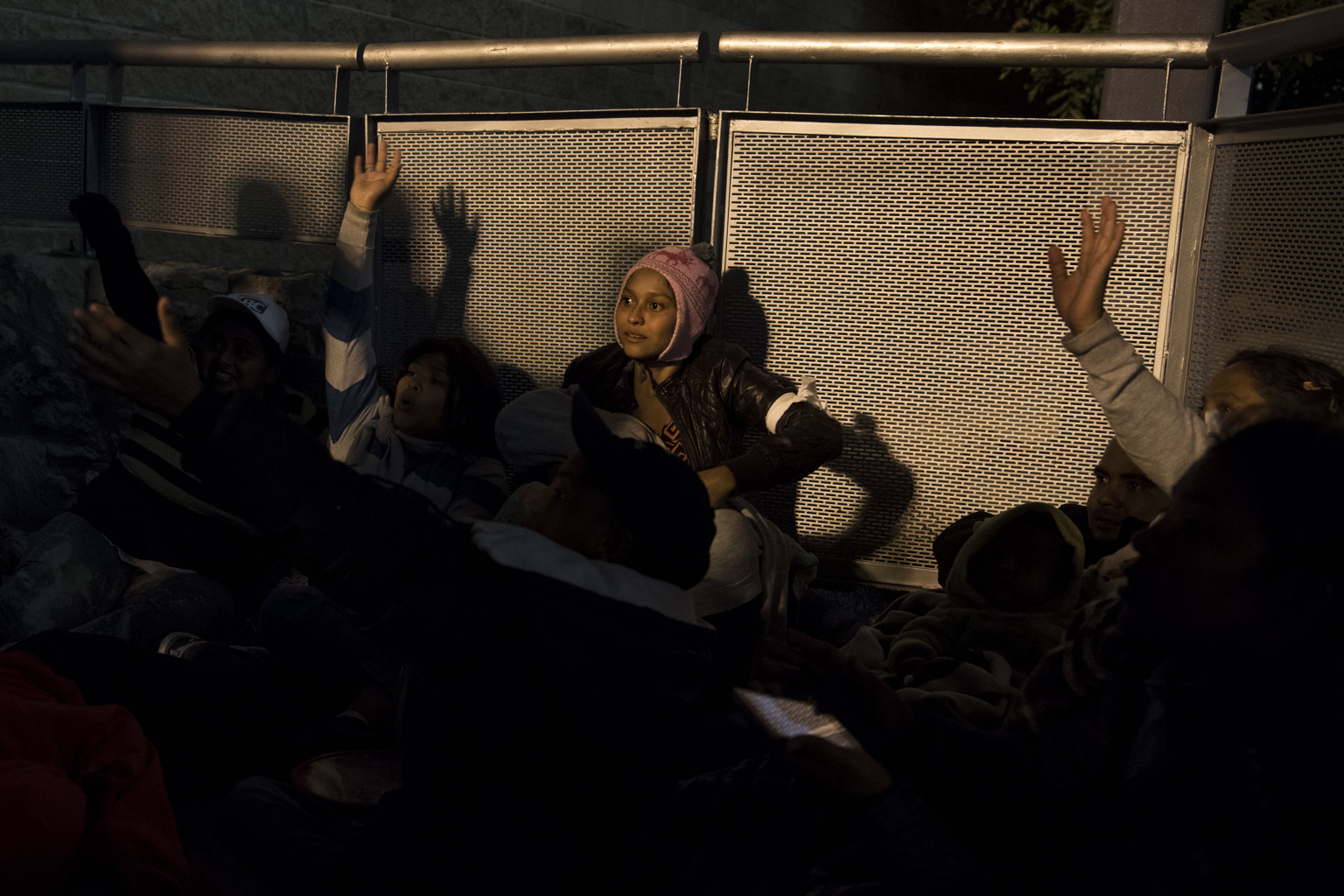
The Road to Asylum: Inside the Migrant Caravans
TIJUANA, MEXICO - APRIL 29: A group of asylum seekers waiting to be processed sit in a holding area at the San Ysidro point of entry in Tijuana, Mexico on April 29, 2018. They raised their hands for blankets. The holding area was outside on concrete and the night was cold. Once this group was put in the holding area, they knew they were going to be the next asylum seekers to be processed. Hundreds were waiting in a queue behind them. Some would be in Tijuana shelters waiting for weeks to be processed. (Photo by Carolyn Van Houten/The Washington Post)
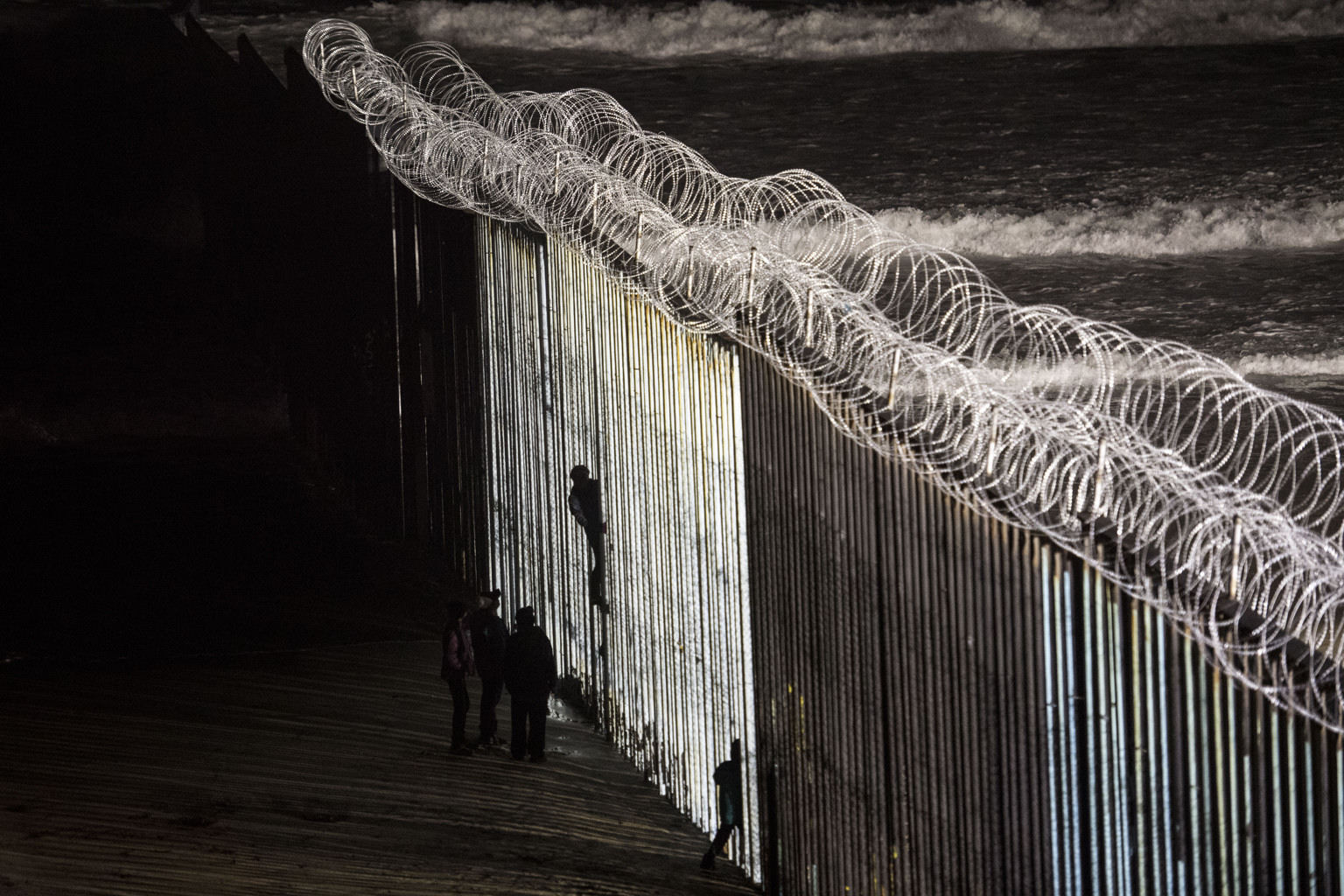
The Road to Asylum: Inside the Migrant Caravans
TIJUANA, MEXICO - DECEMBER 1: Pedro Jimenez, 35, who is fleeing violence in Honduras, tries to climb the border fence at the beach on December 1, 2018 in Tijuana, Mexico. He is trying to get himself and his ten-year-old son across the border to ask for asylum, because his brother was murdered in Honduras. He and his son tried to cross at a different part of the fence, but were approached by someone hiding in the bushes and told they had to pay. They emerged from the area visibly frightened. Pedro was testing the fence to see how best to cross, but did not make it across that night. (Photo by Carolyn Van Houten/The Washington Post)
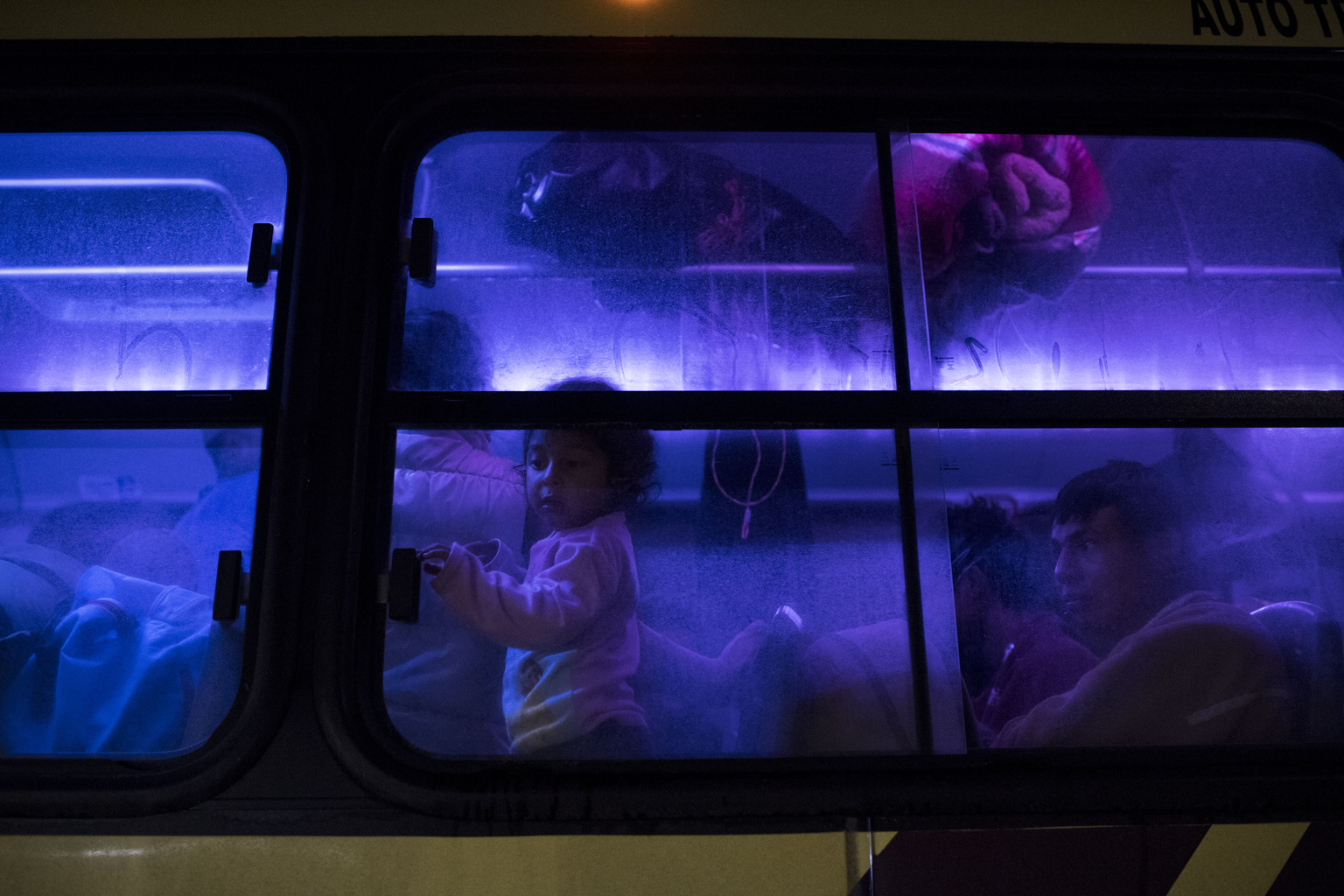
The Road to Asylum: Inside the Migrant Caravans
TIJUANA, MEXICO - NOVEMBER 30: Members of the migrant caravan get onto buses to be transported from Unidad Deportiva Benito Juarez, where the thousands of migrants were staying in tents outside, to a new shelter in a vacant event space called El Barretal on November 29, 2018 in Tijuana, Mexico. They were transported to El Barretal, which is located significantly farther from the border. Advocates said that the area around El Barretal had a concerning amount of gang activity that would threaten asylum seekers fleeing gang violence. A few weeks later, two migrant teens were murdered in Tijuana traveling between shelters to see friends. Gang involvement has not been confirmed. (Photo by Carolyn Van Houten/The Washington Post)
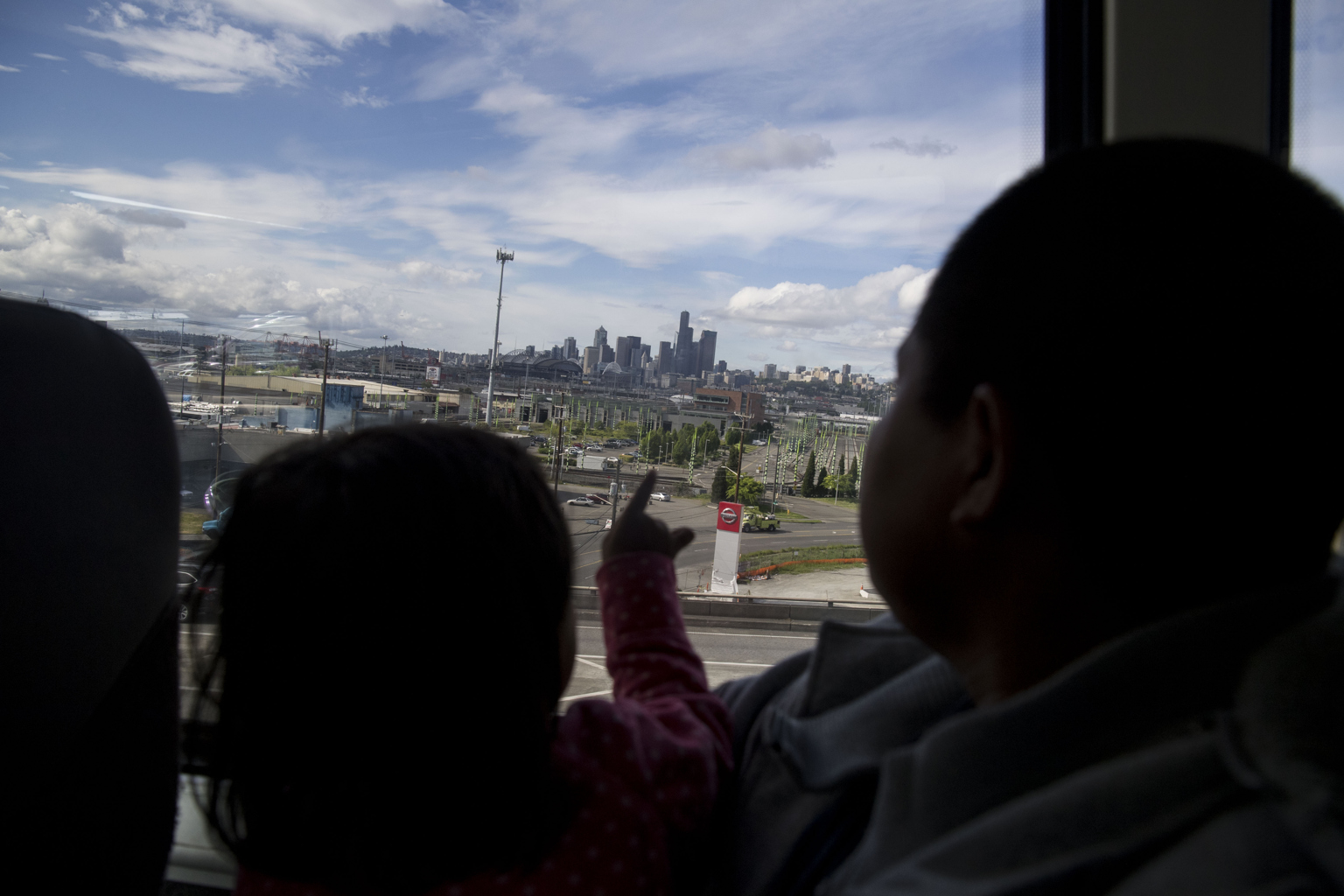
The Road to Asylum: Inside the Migrant Caravans
SEATTLE, WASHINGTON - MAY 10: Carlos Aldana looks as his daughter Alejandra Aldana-Ramos points to the Seattle skyline, which she was seeing for the first time, while on the Greyhound bus to Seattle, Washington on May 10, 2018. Carlos and Alejandra were released from an immigration detention center to go live with Carlos' family in Seattle, while they wait for their asylum case to be processed. Some of the family in Seattle are also waiting for their asylum cases to be processed. Carlos and Alejandra took a Greyhound bus from San Diego, CA straight to Seattle, WA after their release and relied on the kindness of other passengers and bus station employees to get on the proper buses. Many provided them with water and food along the way as well. The journey took more than 30 hours. They have since settled into life with their family in Seattle and are hoping to soon welcome more of their family, who are in Tijuana with the second caravan waiting for the chance for their asylum cases to be processed. (Photo by Carolyn Van Houten/The Washington Post)

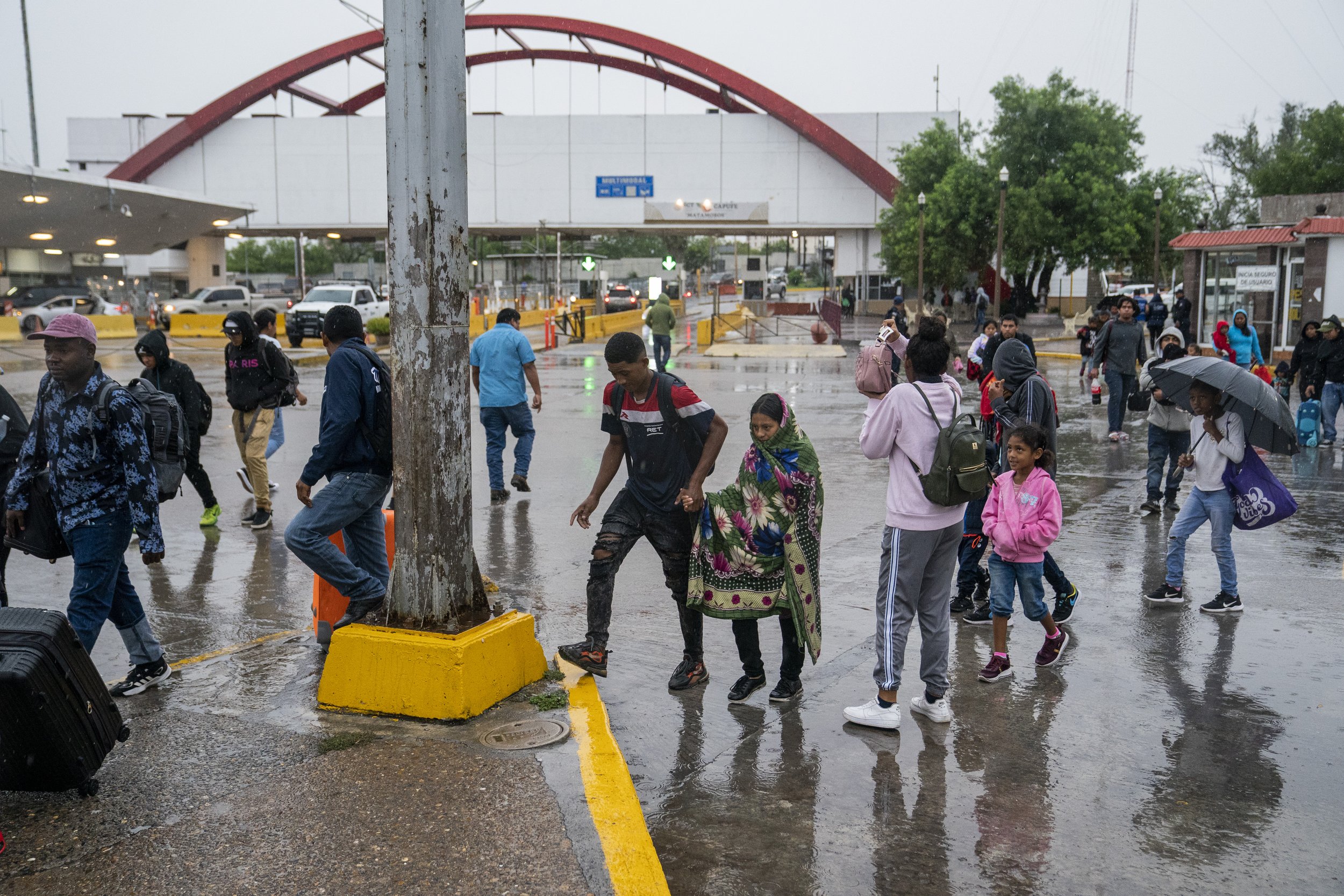
title42
MATAMOROS, MEXICO - May 13:Migrants who had been waiting on the Gateway International Bridge in hopes of getting interviews for asylum in the United States were told to turn back to Mexico to wait as lightning crashes and rain floods the area on May 13, 2023 in Matamoros, Mexico. Many have been waiting months in the camp to get their asylum claim processed legally. When Title 42 expired and Title 8 went into effect, the repercussions for crossing the border illegally became more severe. The flow of migrants crossing the Rio Grande River slowed significantly. However, the conditions at the encampment are squalid and the migrants, especially those seeking asylum, say they have nowhere to turn. (Photo by Carolyn Van Houten/The Washington Post)

title42
MATAMOROS, MEXICO - May 11:Alexander Nova holds Santiago Quintero, 6, as migrants traverse the Rio Grande River in order to cross the United States border as Title 42 expires on May 11, 2023 in Matamoros, Mexico. Title 42 is a Trump-era policy that allows border agents to quickly turn away migrants seeking asylum due to COVID-related concerns. The policy expires at 11:59 pm on May 11, 2023. (Photo by Carolyn Van Houten/The Washington Post)

title42
MATAMOROS, MEXICO - May 11:Migrants try to keep a baby from drowning as they cross the Rio Grande River to the United States border as Title 42 expires on May 11, 2023 in Matamoros, Mexico. Title 42 is a Trump-era policy that allows border agents to quickly turn away migrants seeking asylum due to COVID-related concerns. The policy expires at 11:59 pm on May 11, 2023. (Photo by Carolyn Van Houten/The Washington Post)
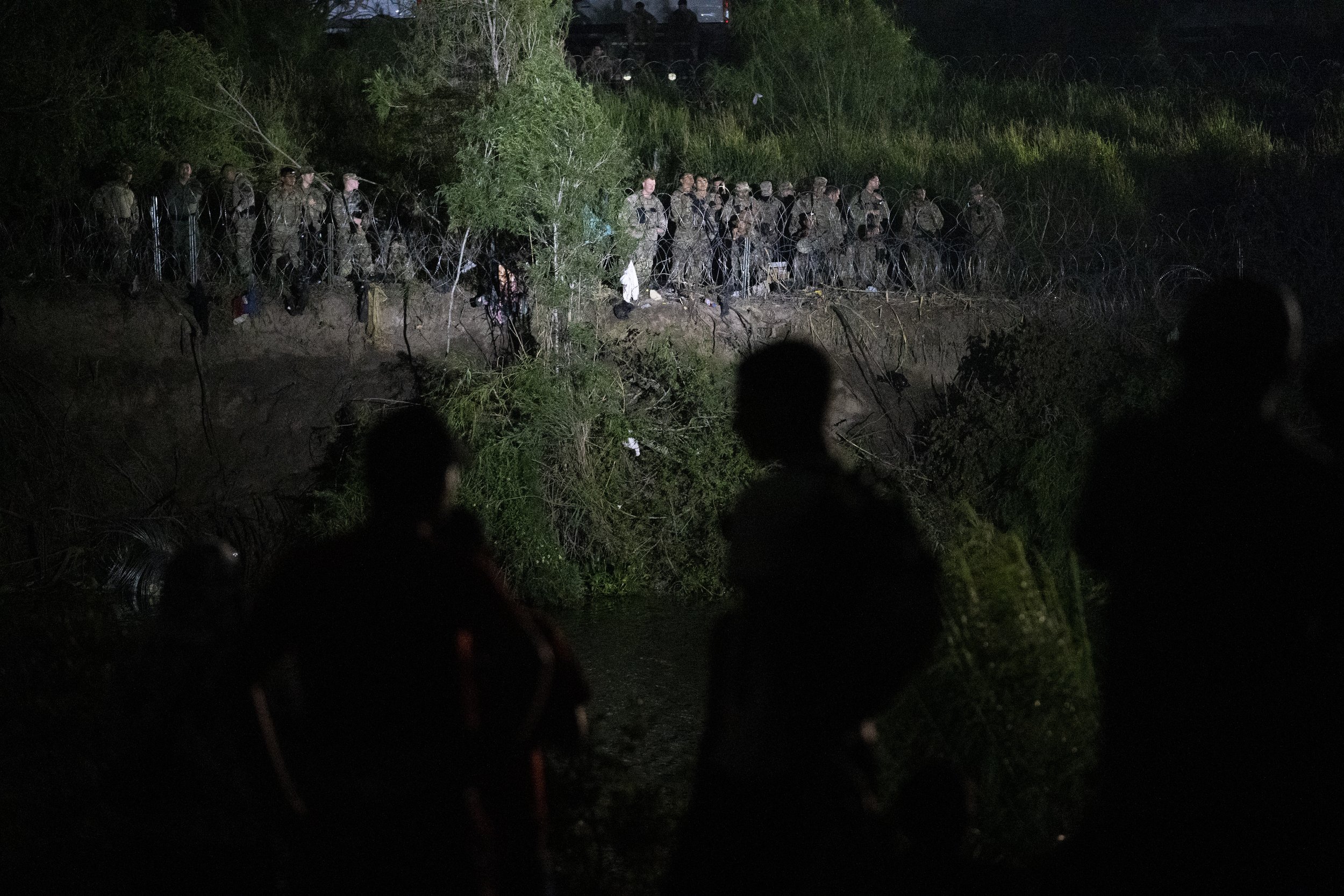
title42
MATAMOROS, MEXICO - May 12:Migrants stand at a river crossing point along the Rio Grande River near the United States border and converse jokingly with officials as Title 42 expires on May 12, 2023 in Matamoros, Mexico. Some will cross the river and others will use an app to apply for asylum and wait in camps like this one often for months. Title 42 is a Trump-era policy that allows border agents to quickly turn away migrants seeking asylum due to COVID-related concerns. The policy expires at 11:59 pm on May 11, 2023. (Photo by Carolyn Van Houten/The Washington Post)
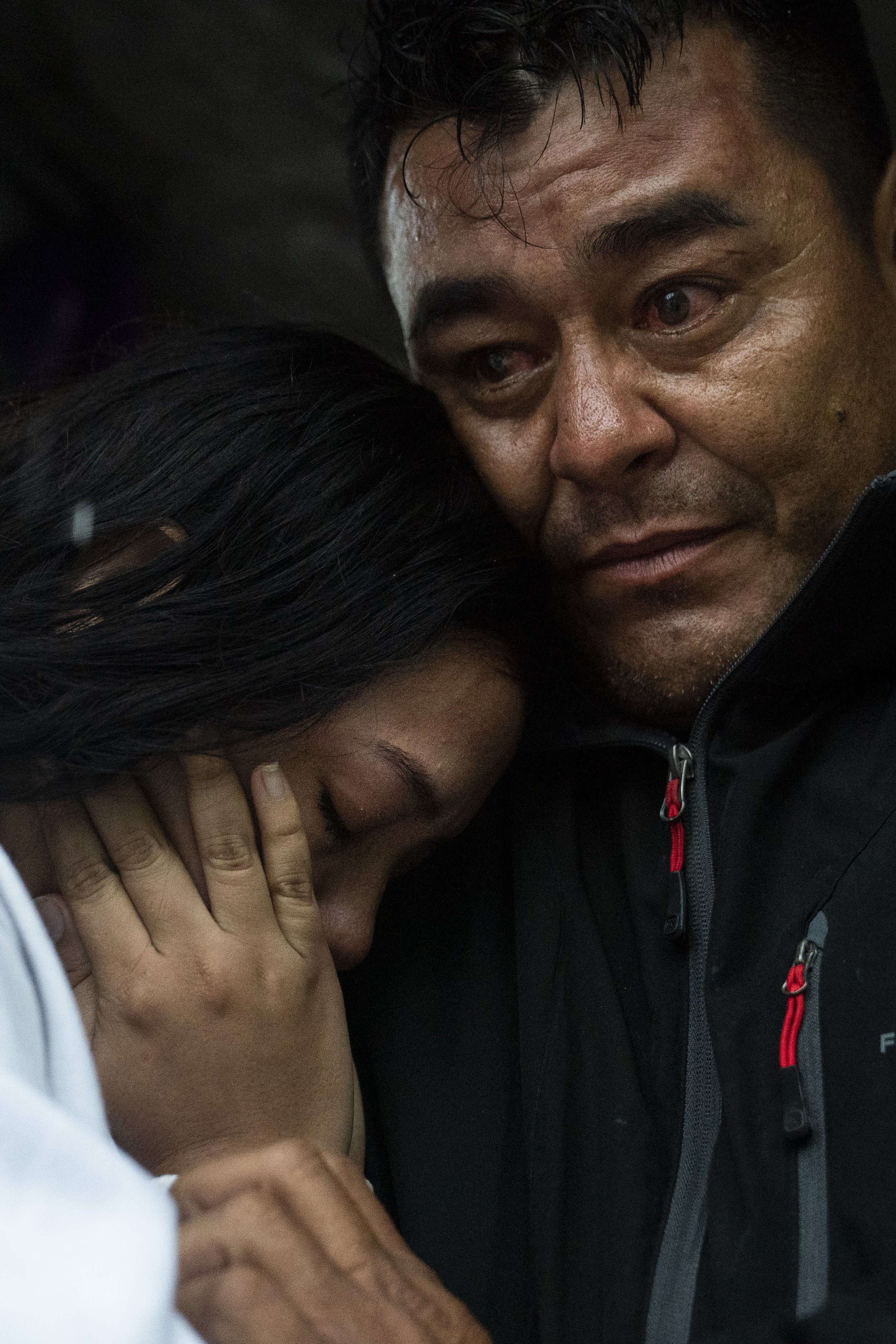
title42
MATAMOROS, MEXICO - May 13:Freddie Castro, 46, holds his daughter Lorena Castro, 23, while they both cry about their predicament as they wait with thousands of migrants in an encampment on May 13, 2023 in Matamoros, Mexico. Lorena is concerned about the future for her two young children. Many have been waiting months in the camp to get their asylum claim processed legally. When Title 42 expired and Title 8 went into effect, the repercussions for crossing the border illegally became more severe. The flow of migrants crossing the Rio Grande River slowed significantly. However, the conditions at the encampment are squalid and the migrants, especially those seeking asylum, say they have nowhere to turn. (Photo by Carolyn Van Houten/The Washington Post)
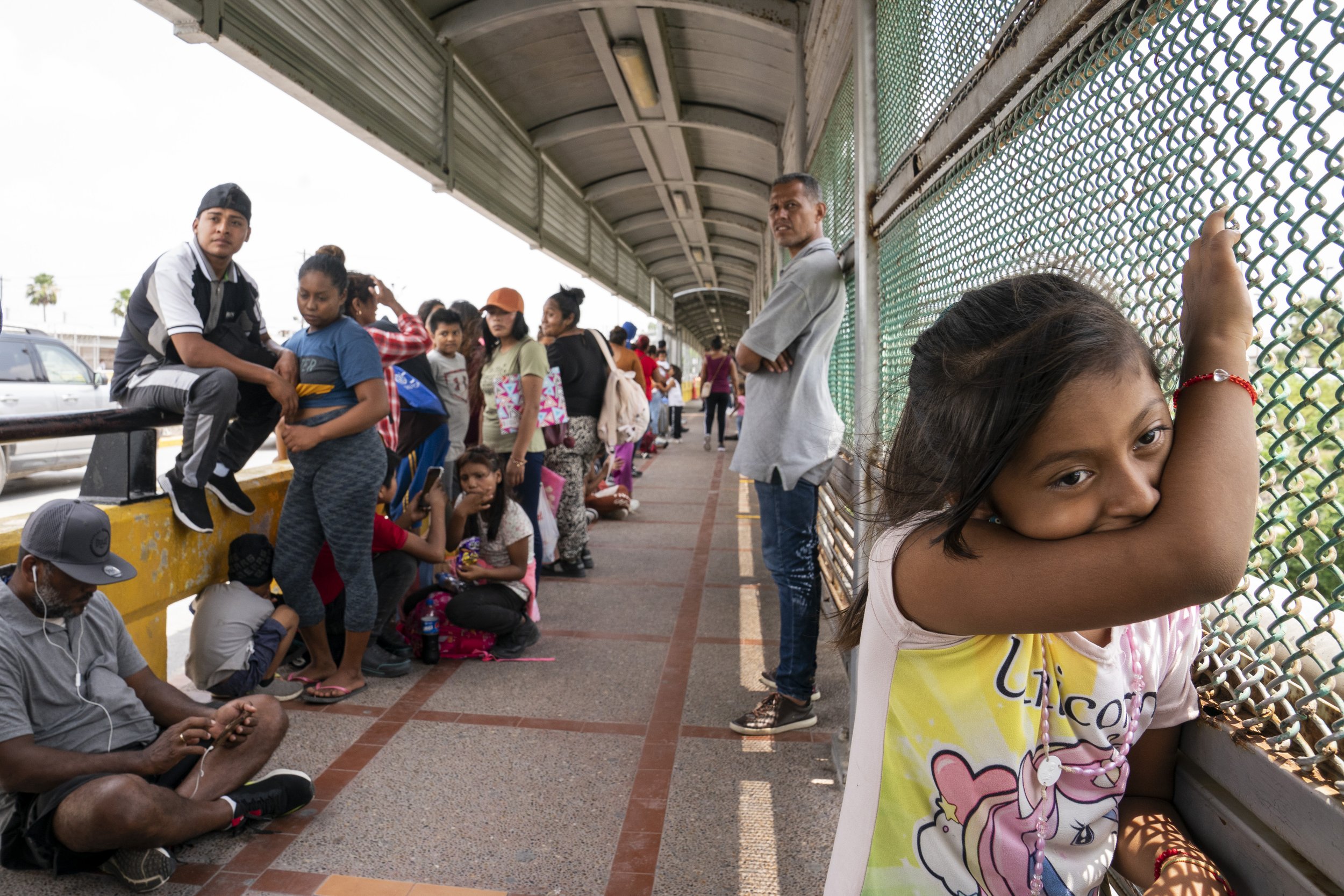
title42
MATAMOROS, MEXICO - May 12:Miley Vasquez, 9, waits with her family in hopes of getting a credible fear interview, a first step in the process of seeking asylum, at the United States border on May 12, 2023 in Matamoros, Mexico. Title 42 was a Trump-era policy that allows border agents to quickly turn away migrants seeking asylum due to COVID-related concerns. The policy expired at 11:59 pm on May 11, 2023. When it expired, Title 8 went into effect. In Title 8, Mexicans can once again seek asylum in the United States. Vasquez’s family said that gang violence in Acapulco, Mexico was driving them from their home so as soon as Title 42 lifted, they wanted to try for asylum. (Photo by Carolyn Van Houten/The Washington Post)
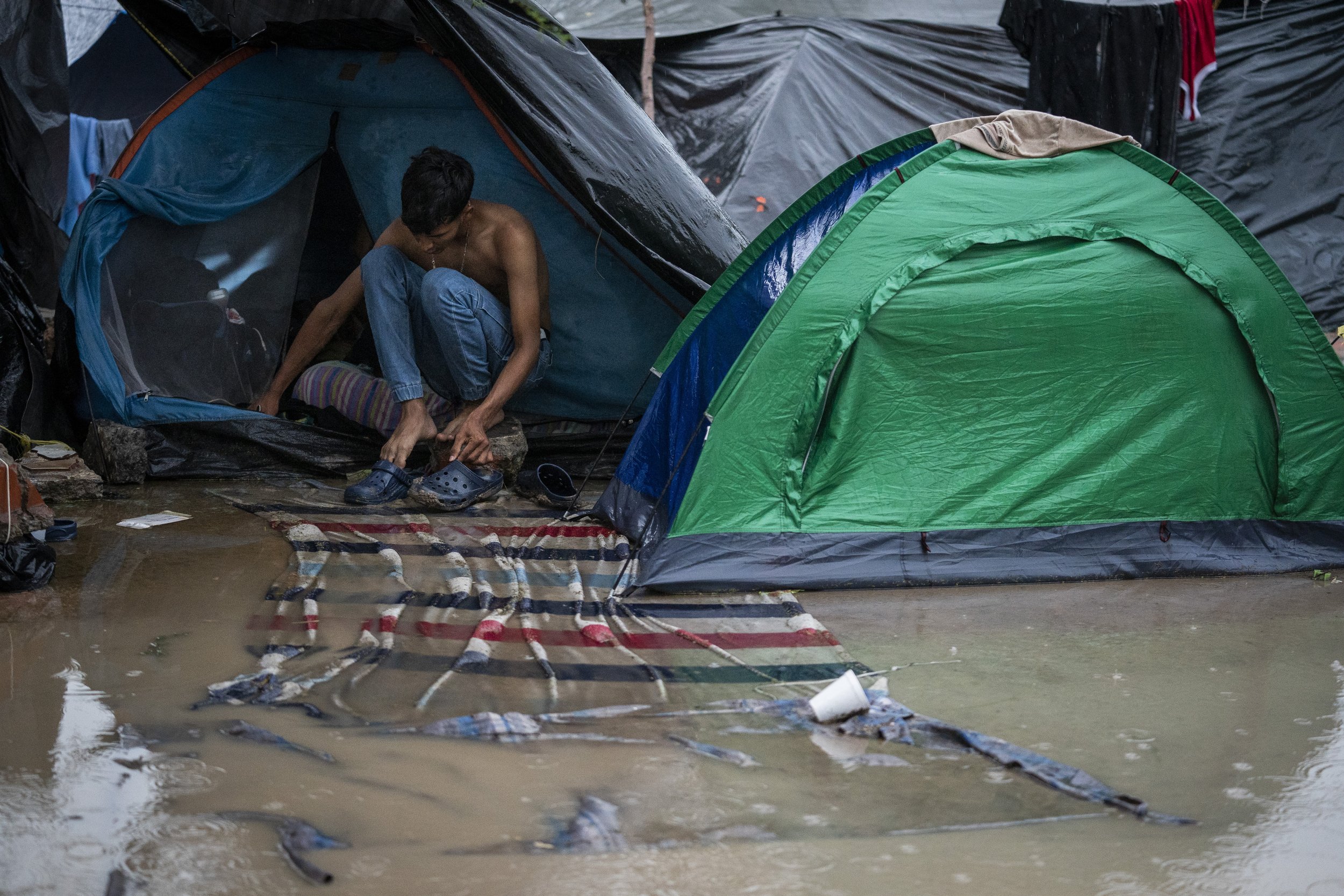
title42
MATAMOROS, MEXICO - May 13:Thousands of migrants wait in an encampment as lightning crashes and rain floods the area on May 13, 2023 in Matamoros, Mexico. Many have been waiting months in the camp to get their asylum claim processed legally. When Title 42 expired and Title 8 went into effect, the repercussions for crossing the border illegally became more severe. The flow of migrants crossing the Rio Grande River slowed significantly. However, the conditions at the encampment are squalid and the migrants, especially those seeking asylum, say they have nowhere to turn. (Photo by Carolyn Van Houten/The Washington Post)
The Road to Asylum: Inside the Migrant Caravans
Throughout 2018 thousands of Central American migrants made the journey from their home countries, often traveling more than 2500 miles across Mexico in caravans to reach the U.S. border. Unsure of what to do next as asylum processes constantly seem to change in the news, they have to decide whether to wait, to turn back, or to cross illegally, often with children in tow. However, if they are lucky, once they cross, the most uncertain, and longest part of their journey – the asylum process – has just begun.
Rodney Scott, chief of the Border Patrol's San Diego sector, looks out towards Tijuana, Mexico, right, as Border Patrol agents respond to a call about people crossing in the distance on April 25, 2018 in San Diego, California.
The Road to Asylum: Inside the Migrant Caravans
SANTIAGO NILTEPEC, MEXICO - OCTOBER 30: Dozens of migrants traveling in a caravan towards the United States border run behind a truck and help each other climb inside on a highway in Santiago Niltepec, Mexico on their way to Juchitan, Mexico on October 30, 2018. The truck did not stop moving when the migrants started climbing in. The migrant caravan was traveling about 30 miles a day, so people were desperate to catch rides however they could in order to avoid walking such long distances every day. (Photo by Carolyn Van Houten/The Washington Post)
The Road to Asylum: Inside the Migrant Caravans
LA VENTOSA, MEXICO - OCTOBER 29: Bessi Zelaya, Johana Hernandez, 16, and Ana Lizeth Velasquez, stand in the road and try to help Keila Savioll Mejia, 21, as her daughter Camila Savioll Mejia, 4, throws a tantrum and refuses to walk any farther in San Pedro Tapanatepec, Mexico on October 29, 2018. They are walking north together among the thousands of migrants traveling in a caravan to the United States border. (Photo by Carolyn Van Houten/The Washington Post)
The Road to Asylum: Inside the Migrant Caravans
JUCHITAN, MEXICO - OCTOBER 30: Thousands of migrants traveling in a caravan towards the United States border rest after traveling more than 30 miles to Juchitan, Mexico on October 30, 2018. Some hitched rides for parts of the journey while others walked. This night they stayed in a stadium complex, which was turned into a temporary camp. Thousands slept here in rows, often only inches apart from each other. Medical care and food were provided. (Photo by Carolyn Van Houten/The Washington Post)
migrantcaravan
JUCHITAN, MEXICO - OCTOBER 30:Brandon Garcia, right, 21, watches his son Caleb Isaac Flores, 7, center, who broke both of his arms recently while playing with other migrant children, in Juchitan, Mexico on October 30, 2018. Thousands of people are a part of the caravan which is heading north to the United States border. (Photo by Carolyn Van Houten/The Washington Post)
The Road to Asylum: Inside the Migrant Caravans
SAN PEDRO TAPANATEPEC, - OCTOBER 28: Some of the thousands of migrants traveling in a caravan towards the United States border stand in line for food in San Pedro Tapanatepec, Mexico on October 28, 2018. Often the men stand in line for food after the families and children have been fed. (Photo by Carolyn Van Houten/The Washington Post)
The Road to Asylum: Inside the Migrant Caravans
Thousands of migrants rest before they continue their walk north towards the United States border in Juchitan, Mexico on November 1, 2018. To get to the border, they are hitching rides on trucks, taking buses, and often walking long distances.
The Road to Asylum: Inside the Migrant Caravans
Almairis Guillen and her son Miguel de Jesus Oseguera, 4, ride on the wheel well of a tanker truck along a highway in Santiago Niltepec, Mexico on their way to Juchitan, Mexico on October 30, 2018. Traveling as a part of the caravan of thousands of migrants, the Honduran mother of five is hoping to make it to the U.S. to ask for asylum. “The truth is that I don’t know if they will help us,” she said.
The Road to Asylum: Inside the Migrant Caravans
SANTIAGO NILTEPEC, MEXICO - OCTOBER 30: Some of the thousands of migrants traveling in a caravan towards the United States border walk along the side of a highway while others hitch a ride in a truck in Santiago Niltepec, Mexico on their way to Juchitan, Mexico on October 30, 2018. While hundreds caught rides from local passersby or leapt onto passing trucks, those methods were risky for many families with small children, so they often walked straggling behind the rest of the group. (Photo by Carolyn Van Houten/The Washington Post)
The Road to Asylum: Inside the Migrant Caravans
JUCHITAN, MEXICO - OCTOBER 31: Keneth Arguijo Gonzalez, 10, stands with his feet wrapped to cover the open blisters and heat damage that are affecting his feet as the migrant caravan he is traveling with rests in Juchitan, Mexico on October 31, 2018. Thousands of people are a part of the caravan which is heading north to the United States border. To get to the border, they are hitching rides on trucks, taking buses, and often walking long distances. (Photo by Carolyn Van Houten/The Washington Post)
The Road to Asylum: Inside the Migrant Caravans
SAN PEDRO TAPANATEPEC, - OCTOBER 28: Some of the thousands of migrants traveling in a caravan towards the United States border play and wash off in the Rio Novillero in San Pedro Tapanatepec, Mexico on October 28, 2018. Occasionally, the caravan would remain in a town for an extra day along their route to rest, wash, and take care of any medical issues people may have incurred along the journey. The scene was lighthearted and playful, despite exhaustion and heat. (Photo by Carolyn Van Houten/The Washington Post)
The Road to Asylum: Inside the Migrant Caravans
HIDALGO COUNTY, TEXAS - AUGUST 15: Border Patrol agent Robert Rodriguez watches a group of smugglers in Mexico from the United States side of the Rio Grande River in Hidalgo County, Texas on August 15, 2018. A young smuggler paddled a raft across the river carrying Cecilia Ulloa, 25, and her son, Darwin, 13. The Hondurans were crossing in hopes of seeking asylum in the United States. (Photo by Carolyn Van Houten/The Washington Post)
The Road to Asylum: Inside the Migrant Caravans
TIJUANA, MEXICO - DECEMBER 2: A group of migrants, including a child, cross the border fence illegally to present themselves to Border Patrol agents on December 2, 2018 in Tijuana, Mexico. Many migrants who are a part of the migrant caravan have chosen to cross illegally and ask for asylum rather than wait weeks, or possibly even months, in a shelter until their turn comes to legally present themselves to ask for asylum at a border checkpoint. (Photo by Carolyn Van Houten/The Washington Post)
bordercrossing
EL PASO, TEXAS - FEBRUARY 22:Migrant families walk around the area with mylar blankets in order to stay warm while waiting for about an hour to be processed and transported by Border Patrol in El Paso, Texas on February 22, 2019. The mylar blankets were distributed by Border Patrol agents to protect against the near-freezing temperatures while the migrants wait to be processed and transported to a nearby holding facility. The group of 64 migrants walked across the Rio Grande river and presented themselves to Border Patrol agents near the BNSF Rail Yard on the western edge of downtown El Paso. Many of the Central American migrants are families asking for asylum in the United States. (Photo by Carolyn Van Houten/The Washington Post)
The Road to Asylum: Inside the Migrant Caravans
MISSION, TEXAS - AUGUST 15: A group of men who crossed the U.S. border illegally and tried to run from Border Patrol agents are detained in Mission, Texas on August 15, 2018. The Border Patrol used helicopters, cameras, and agents on foot to track the men as they tried to flee. The men were quickly detained, given an electrolyte beverage, processed and placed in a van for transport. Much of the national narrative around asylum is muddled with the conversation about illegal immigration. (Photo by Carolyn Van Houten/The Washington Post)
The Road to Asylum: Inside the Migrant Caravans
TIJUANA, MEXICO - APRIL 26: Elvia Ramos, right, looks down the street as her partner Carlos Aldana holds their daughter Fernanda Aldana-Ramos, 1, at the Movimiento Juventud 2000 shelter on April 26, 2018 in Tijuana, Mexico. Ramos and her family fled Honduras after two of Aldana's brothers were killed and their lives were threatened. Hundreds of migrants from Central America traveled for about a month across Mexico to reach the United States border. A few days later they went to the San Ysidro border crossing south of San Diego, California, where they and many of the migrants in the caravan sought asylum. (Photo by Carolyn Van Houten/The Washington Post)
The Road to Asylum: Inside the Migrant Caravans
TIJUANA, MEXICO - MAY 14: Ingrid Hernandez sits in silence in her friend Elvia Aldana's tent in the Movimiento Juventud 2000 shelter in Tijuana, Mexico after trying and failing to reach her husband Misael Bonilla in the immigration detention center where he and their son, Leonel, were being held on May 14, 2018. She was trying to find out if they were going to be released soon, because she did not want to present herself and her other two children at the border until she knew Misael and Leonel were safe and with her father in the Bronx, New York. While sitting in the tent, she talked to Elvia about her concerns and their plan to walk to the San Ysidro border crossing to find out how long they needed to wait to present themselves and ask for asylum. Ingrid was conflicted because she did not want to cross without hearing from Misael, but she also did not want her family to miss their place in the waiting list to ask for asylum. If she decided to postpone, the three of them would have to stay in the shelter at least another week. (Photo by Carolyn Van Houten/The Washington Post)
The Road to Asylum: Inside the Migrant Caravans
TIJUANA, MEXICO - NOVEMBER 30: Standing water remains after heavy rains flooded the stadium complex where members of the migrant caravan were staying in tents on November 30, 2018 in Tijuana, Mexico. Partially due to the squalid conditions, the thousands of migrants with the caravan were moved to a different shelter across the city. (Photo by Carolyn Van Houten/The Washington Post)
The Road to Asylum: Inside the Migrant Caravans
TIJUANA, MEXICO - MAY 1: Evelyn Vega lays her head on Elmer Zelaya Gomez while their daughter Nayely Vega, 7, rests next to them under a tarp that is attached to the bars on the edge of the San Ysidro border crossing on May 1, 2018 in Tijuana, Mexico. They are among the group of Central American migrants waiting to walk to the United States border and have their cases processed. Stripes representing the Mexican flag loom over their heads as if a reminder of how far they still have to go. "We want to start another life, but it is not easy," Gomez said. A gang in his home country of El Salvador killed his son in February and threatened his family, he said. Hundreds of migrants from Central America traveled for about a month across Mexico to reach the United States border. Many of the migrants will seek asylum. (Photo by Carolyn Van Houten/The Washington Post)
The Road to Asylum: Inside the Migrant Caravans
TIJUANA, MEXICO - APRIL 29: A group of asylum seekers waiting to be processed sit in a holding area at the San Ysidro point of entry in Tijuana, Mexico on April 29, 2018. They raised their hands for blankets. The holding area was outside on concrete and the night was cold. Once this group was put in the holding area, they knew they were going to be the next asylum seekers to be processed. Hundreds were waiting in a queue behind them. Some would be in Tijuana shelters waiting for weeks to be processed. (Photo by Carolyn Van Houten/The Washington Post)
The Road to Asylum: Inside the Migrant Caravans
TIJUANA, MEXICO - DECEMBER 1: Pedro Jimenez, 35, who is fleeing violence in Honduras, tries to climb the border fence at the beach on December 1, 2018 in Tijuana, Mexico. He is trying to get himself and his ten-year-old son across the border to ask for asylum, because his brother was murdered in Honduras. He and his son tried to cross at a different part of the fence, but were approached by someone hiding in the bushes and told they had to pay. They emerged from the area visibly frightened. Pedro was testing the fence to see how best to cross, but did not make it across that night. (Photo by Carolyn Van Houten/The Washington Post)
The Road to Asylum: Inside the Migrant Caravans
TIJUANA, MEXICO - NOVEMBER 30: Members of the migrant caravan get onto buses to be transported from Unidad Deportiva Benito Juarez, where the thousands of migrants were staying in tents outside, to a new shelter in a vacant event space called El Barretal on November 29, 2018 in Tijuana, Mexico. They were transported to El Barretal, which is located significantly farther from the border. Advocates said that the area around El Barretal had a concerning amount of gang activity that would threaten asylum seekers fleeing gang violence. A few weeks later, two migrant teens were murdered in Tijuana traveling between shelters to see friends. Gang involvement has not been confirmed. (Photo by Carolyn Van Houten/The Washington Post)
The Road to Asylum: Inside the Migrant Caravans
SEATTLE, WASHINGTON - MAY 10: Carlos Aldana looks as his daughter Alejandra Aldana-Ramos points to the Seattle skyline, which she was seeing for the first time, while on the Greyhound bus to Seattle, Washington on May 10, 2018. Carlos and Alejandra were released from an immigration detention center to go live with Carlos' family in Seattle, while they wait for their asylum case to be processed. Some of the family in Seattle are also waiting for their asylum cases to be processed. Carlos and Alejandra took a Greyhound bus from San Diego, CA straight to Seattle, WA after their release and relied on the kindness of other passengers and bus station employees to get on the proper buses. Many provided them with water and food along the way as well. The journey took more than 30 hours. They have since settled into life with their family in Seattle and are hoping to soon welcome more of their family, who are in Tijuana with the second caravan waiting for the chance for their asylum cases to be processed. (Photo by Carolyn Van Houten/The Washington Post)
title42
MATAMOROS, MEXICO - May 13:Migrants who had been waiting on the Gateway International Bridge in hopes of getting interviews for asylum in the United States were told to turn back to Mexico to wait as lightning crashes and rain floods the area on May 13, 2023 in Matamoros, Mexico. Many have been waiting months in the camp to get their asylum claim processed legally. When Title 42 expired and Title 8 went into effect, the repercussions for crossing the border illegally became more severe. The flow of migrants crossing the Rio Grande River slowed significantly. However, the conditions at the encampment are squalid and the migrants, especially those seeking asylum, say they have nowhere to turn. (Photo by Carolyn Van Houten/The Washington Post)
title42
MATAMOROS, MEXICO - May 11:Alexander Nova holds Santiago Quintero, 6, as migrants traverse the Rio Grande River in order to cross the United States border as Title 42 expires on May 11, 2023 in Matamoros, Mexico. Title 42 is a Trump-era policy that allows border agents to quickly turn away migrants seeking asylum due to COVID-related concerns. The policy expires at 11:59 pm on May 11, 2023. (Photo by Carolyn Van Houten/The Washington Post)
title42
MATAMOROS, MEXICO - May 11:Migrants try to keep a baby from drowning as they cross the Rio Grande River to the United States border as Title 42 expires on May 11, 2023 in Matamoros, Mexico. Title 42 is a Trump-era policy that allows border agents to quickly turn away migrants seeking asylum due to COVID-related concerns. The policy expires at 11:59 pm on May 11, 2023. (Photo by Carolyn Van Houten/The Washington Post)
title42
MATAMOROS, MEXICO - May 12:Migrants stand at a river crossing point along the Rio Grande River near the United States border and converse jokingly with officials as Title 42 expires on May 12, 2023 in Matamoros, Mexico. Some will cross the river and others will use an app to apply for asylum and wait in camps like this one often for months. Title 42 is a Trump-era policy that allows border agents to quickly turn away migrants seeking asylum due to COVID-related concerns. The policy expires at 11:59 pm on May 11, 2023. (Photo by Carolyn Van Houten/The Washington Post)
title42
MATAMOROS, MEXICO - May 13:Freddie Castro, 46, holds his daughter Lorena Castro, 23, while they both cry about their predicament as they wait with thousands of migrants in an encampment on May 13, 2023 in Matamoros, Mexico. Lorena is concerned about the future for her two young children. Many have been waiting months in the camp to get their asylum claim processed legally. When Title 42 expired and Title 8 went into effect, the repercussions for crossing the border illegally became more severe. The flow of migrants crossing the Rio Grande River slowed significantly. However, the conditions at the encampment are squalid and the migrants, especially those seeking asylum, say they have nowhere to turn. (Photo by Carolyn Van Houten/The Washington Post)
title42
MATAMOROS, MEXICO - May 12:Miley Vasquez, 9, waits with her family in hopes of getting a credible fear interview, a first step in the process of seeking asylum, at the United States border on May 12, 2023 in Matamoros, Mexico. Title 42 was a Trump-era policy that allows border agents to quickly turn away migrants seeking asylum due to COVID-related concerns. The policy expired at 11:59 pm on May 11, 2023. When it expired, Title 8 went into effect. In Title 8, Mexicans can once again seek asylum in the United States. Vasquez’s family said that gang violence in Acapulco, Mexico was driving them from their home so as soon as Title 42 lifted, they wanted to try for asylum. (Photo by Carolyn Van Houten/The Washington Post)
title42
MATAMOROS, MEXICO - May 13:Thousands of migrants wait in an encampment as lightning crashes and rain floods the area on May 13, 2023 in Matamoros, Mexico. Many have been waiting months in the camp to get their asylum claim processed legally. When Title 42 expired and Title 8 went into effect, the repercussions for crossing the border illegally became more severe. The flow of migrants crossing the Rio Grande River slowed significantly. However, the conditions at the encampment are squalid and the migrants, especially those seeking asylum, say they have nowhere to turn. (Photo by Carolyn Van Houten/The Washington Post)































